Home Blog Presentation Ideas How to Give A Compelling Interview Presentation: Tips, Examples and Topic Ideas

How to Give A Compelling Interview Presentation: Tips, Examples and Topic Ideas

Interview presentations have now become the new norm for most industries. They are popular for sales, marketing, technology, and academic positions. If you have been asked to deliver one for your job interview presentation, prepare to build a strong case for yourself as a candidate.
Giving a general presentation is already daunting. But selling yourself is always the hardest. Spectacular credentials and stellar expertise don’t count much if you cannot present them clearly, which you are expected to do during your interview presentation.
So, let’s prime you up for the challenge. This post is action-packed with job interview PowerPoint presentation examples and will teach you the best way to do a presentation without stressing too much!
Table of Contents
What is an Interview Presentation?
What should an interview presentation look like, how to prepare for a job interview presentation: the basics, define your structure, what slides to include, how to come up with 15-minute interview presentation ideas, how to conclude your interview presentation, how to prepare for an interview: the final tips, what to do at the first interaction with the company elevator pitch for interview, presentation design tips, how to overcome presentation anxiety, tips on maintaining positive body language throughout the presentation, your final act.
An interview presentation, also known as a job interview presentation or interview portfolio, is a formal and structured way for candidates to showcase their skills, qualifications, and suitability for a specific job position during an interview. It goes beyond the typical Q&A format of interviews, allowing candidates to demonstrate their expertise through a prepared presentation. Employers commonly request interview presentations in various industries, such as sales, marketing, technology, academia, and management roles. These presentations serve several important purposes: assessing communication skills, evaluating cultural fit, measuring expertise, analyzing problem-solving skills, and observing presentation skills. While the specific format and requirements of interview presentations vary widely, candidates typically receive guidelines from the employer regarding the topic, duration, and any specific criteria to be addressed. In essence, an interview presentation is an opportunity for candidates to make a compelling case for their candidacy, showcasing their qualifications, experience, and suitability for the job. It requires careful preparation, effective communication, and the ability to engage and persuade the interview panel. A successful interview presentation can significantly enhance a candidate’s chances of securing the desired position.
Think of your interview presentation as a sales pitch.
Your goal is to convince the human resources team that you are the best candidate. The kick here is that you will present to a warm audience – you already impressed them enough with your resume to be called in for an interview. We recommend generating a strategy and presentation based on a 30 60 90 Day Plan .
Employers request interview presentations for a few simple reasons:
- To assess your communication and public speaking skills.
- To understand whether you are the right cultural fit for the company.
- To develop a better sense of how well-versed you are in the domain .
So, your first job is ensuring your presentation fits the criteria. Review the company’s job description again and jot down all the candidate requirements. Take the time to read about their company values and mission. Be proactive and ask precisely what you should cover during your presentation.
Most interview presentations will differ in content and style, but here’s a quick example to give you more context:

[ Use This Template ]
Before you get elbow-deep in designing that PowerPoint for a job interview presentation, do some scouting and reach out to the HR team with a few questions.
You want your presentation to be on-point and technically accurate, so ask your contact the following:
- How long should an interview presentation be? Fifteen minutes is the golden standard, though some employers may ask to cut it down to just 10 minutes or extend it to 20-25.
- Who exactly will be present? A conversational presentation would undoubtedly be welcomed by your peers and a team leader but may appear too casual for the senior managers or board of directors.
- Does the HR team have a particular agenda in mind? Ask some leading questions to understand what kind of skills/experience they want you to demonstrate. If needed, use a proper agenda slide to include your content.
- What’s the IT setup? Should you bring your laptop? Do you need an adapter to connect to their projector? What kind of presentation software have they installed – PowerPoint, Keynote, Google Slides?
Everyone appreciates clarity.
In fact, 89% of professionals state their ability to communicate with clarity directly impacts their career and income.
Your presentation should flow, not rumble. Make sure that your story is easy to follow and your key message is easy to digest, remember, and pass on. If you want people to retain your main points, opt for the following structure:

Source: this infographic was created with 3 Steps Editable 3D Ladder Infographic
Here’s an interview presentation example styled in this fashion.
What is: The company’s presence in the Middle East is low. Only 15% of revenues come from the top markets.
Why this matters: The UAE fashion market alone is expected to grow at a CAGR of 21% during the next five years.
What could be: I have helped my previous employer open a flagship store in Dubai, have a lot of industry contacts, and am familiar with the local legislature. Your brand can expect a 17% revenue growth within one year of opening.
You can find even more ideas for designing your presentations in this post .
The choice of slides will largely depend on whether you are asked to talk about yourself or present on some task that you will be required to do as part of your job (e.g., create marketing campaigns).
Most interview presentation templates feature the following slides:
- Opening Slide
- Quick Bio/Personal Summary
- Career Path
- Education timeline
- Key Skills and Expertise
- Case studies/examples of the problems you have solved at your past jobs
- Your vision for your future role.
- What exactly can you bring in as the candidate (we will come back to this one later on!)
Can’t figure out where to start? Check out our AI PowerPoint generator to create an entire interview slide deck in a couple of clicks, or just download a job interview template . Swipe down to learn from the either of the following job interview presentation samples.
Typically, a talent acquisition team will suggest broad interview presentation topics for you. For example, if you are applying for a sales position, they may ask you to develop a sales presentation for some product (real or imaginary).
Some employers will request a short presentation about you or your hobbies to understand whether you are a good “fit” for the team and share the company’s values. Remember this: your audience will be assessing your aptitude for the role, no matter which topic you were given.
In fact, the interviewers at this point don’t care that much about your experience and skills. They want to know how you can apply those to solve the company’s pressing problems – meet sales targets, improve ROI from social media marketing or help them earn more revenue.
Your job is to make an educated guess… predict the most wrenching problem, and pitch your “magic pill” during your interview presentation.
I know what you are thinking – but how do I find the right opportunity/problem to tackle?
Businesses across different industries pretty much struggle with the same generic challenges related to either of the following:
Your topic should clearly address one of these areas and offer a potential roadmap for solving some specific problem within it.
Let’s say that you are applying for a sales role. Clearly, you will want to tackle the “customer audience” set of problems. To refine your idea, ask yourself the following questions:
- Can you think of a new customer segment the company should target? Who are they, what do they want, and how you can help the company reach them?
- Do you have a network or experience to identify and pitch new clients?
- Can you think of new collaboration opportunities the company could use to attract a whole new niche of customers?
So a sample job interview presentation about yourself should include a series of Problem & Solution Slides , showing exactly how you will address that issue if the company hires you.
Here’s another PowerPoint presentation about yourself for job interview example worth using – incorporate a case study slide, showing how you have successfully solved a similar problem for your past employer.
Wrap up your presentation by laying out the key steps the company needs to take. Give an estimate of how much time it will take to tackle the problem, and what changes/investments should be made.
Your conclusion should tell this: “Hire me and I will solve this problem for you in no time!”.

Source: StockSnap
Dial-Up Your Power
Take a deep breath and strike a “power pose” before you enter the room.
According to her research, power posers performed better during interviews and were more likely to get hired. Another study also proved this theory: unaware judges gave major preference to the power-primed applicants. So yes, pep talks do work!
The first 30 Seconds Count The Most
What you do and say in the first 30 seconds will make the most impact. Psychological research shows that listeners form opinions about your personality and intelligence in the first 30 seconds of the interview. So be sure to start with a compelling opening, framing exactly how you want to be perceived.
Try To Appear Similar to the Interviewer
Lauren Rivera, a professor from Kellogg School, came to the conclusion that interviewers tend to hire “people like them” .
Even the top human resource management folks fall for this bias and tend to base their evaluations on how similar a candidate is to them, instead of trying to decide whether the person’s skill set is ideal for the position. So to be liked, you will have to act relatable.
Back up your statements with facts
To deliver a presentation with a bang, you can make use of pre-analyzed facts to support your hypothesis. Make sure to do your homework, study the company and its competitive landscape, and do the professional work you would have done as a member of the company crew. At some point in your interview presentation, you go “off the script”, and pull out a bunch of documents, supporting your statements.

For example, you can give away a quick plan indicating a number of things the employer could do today to save money, even if they don’t hire you. Make sure to be meticulous; your work will speak for you. But giving away this work will show the employer your commitment, skills, and focus.
And that’s exactly how to make your job interview presentation stand out. Most candidates just ramble about their skills and past career moves. You bring specificity and proof to the platter, showing exactly what makes you a great hire fair and square.
Within a selection process, there are many interactions (interviews and dynamics) that you must successfully complete in order to be the next selected candidate. One of your objectives in this first interaction should be to generate a great first impression in the company. For this, we recommend using the Elevator Pitch for Interview technique.
The Elevator Pitch for Interview will allow you to present yourself in a solid and professional way in less than 60 seconds, in order to generate an outstanding first impression.
What is an Elevator Pitch for an Interview?
The Elevator Pitch is a condensed speech about yourself that aims to generate engagement in no more than 60 seconds. Entrepreneurs widely use this type of speech to persuade investors and job seekers in job interviews. Your Elevator Pitch for the Interview will generate a great first impression to the employer and be better positioned than other candidates. If your goal is to make a convincing presentation in a job interview, your Elevator Pitch needs to be well crafted.
How to Make an Elevator Pitch for an Interview
There are many ways and tips to make an excellent Elevator Pitch for a job interview. This section provides you with essential advice to make your interview more convincing.
Identify your target
You need to know to whom you are presenting yourself. Is it a recruiter? or an executive?. Your Elevator Pitch will change depending on the receiver.
Comprehend the needs of the hiring company
Make an advanced study about the search requirements for the job position. Identify your strengths. Highlight them. Demonstrate your experience. Identify your weaknesses. Show that you have a profile that seeks constant improvement
Create a clear, concise, and truthful Elevator Pitch
This point is critical. Your Elevator Pitch must be clear, concise, genuine, and impactful. Go from less to more. Generate a real hook in your audience. Try not to go off-topic or talk too much, and be brief in everything you want to say.
Speak naturally and confidently
If you can speak fluently and naturally, you can show a confident profile. Show you know what you are talking about and what you want.
Elevator Pitch Example for Job Seekers
This section illustrates an Elevator Pitch Example targeted to Recruiters. It will help you put together your own.
“My name is [NAME]. After graduating with a degree in Business Administration, I have spent the last five years accumulating professional experience as a Project Assistant and Project Manager. I have successfully managed intangible products’ planning, strategy, and launch these past few years. I was excited to learn about this opportunity in Big Data – I’ve always been passionate about how technology and the use of information can greatly improve the way we live. I would love the opportunity to bring my project management and leadership skills to this position.”
Ways to avoid common mistakes in your Elevator Pitch
Keep in mind the following points to avoid making mistakes in your Elevator Pitch for an Interview.
Don’t hurry to make your Elevator Pitch
The Elevator Pitch lasts approximately 60 seconds. Do it on your own time and naturally, as long as you make it clear and concise.
Do not always use the same Elevator Pitch for all cases
One recommendation is not to repeat the same Elevator Pitch in all your interviews. Make changes. Try new options and ways of saying the information. Try different versions and check with your experience which generates more engagement and persuasion.
Make it easy to understand
Articulate your pitch as a story. Think that the person in front of you does not know you and is interested in learning more about your profile. Don’t make your Elevator Pitch challenging to appear more sophisticated. Simply generate a clear and easy-to-understand narrative, where all the data you tell is factual and verifiable.
Don’t forget to practice it
Practice is the key to success. Your Elevator Pitch for Interview will become more professional, convincing, and natural with practice.
How to End an Elevator Pitch?
An essential aspect of ending an Elevator Pitch for an Interview is demonstrating interest and passion for the position. You have already presented yourself and established that you have the necessary background for the job. Closing with phrases revealing passion and attitude will help reinforce your pitch.
We recommend you use expressions such as:
“I have always been interested and curious about the area in which the company operates, and it would be a great challenge for me to be able to perform in this position.”
“I have been interested in moving into your company for a while, and I love what your team is doing in IT.”
“I would like to advance my career with an employer with the same values. I know that thanks to my profile and experience, I can make excellent contributions to your company.”
Keep It Visual: Use visuals like images, graphs, and charts to convey your points effectively. Visuals can make complex information more accessible and engaging. Consistency Matters: Maintain a consistent design throughout your presentation. Use the same fonts, color schemes, and formatting to create a cohesive look. Practice Timing: Be mindful of the allotted time for your presentation. Practice to ensure you can comfortably cover your content within the time limit. Engage the Audience: Incorporate elements that engage the audience, such as questions, anecdotes, or real-world examples. Interaction keeps the interview panel interested. Use White Space: Avoid cluttered slides. Use white space to create a clean and uncluttered design that enhances readability.
Presenting during a job interview can be nerve-wracking. Here are some strategies to overcome presentation anxiety:
- Practice: Practice your presentation multiple times, ideally in front of a friend or mentor. The more you rehearse, the more confident you’ll become.
- Visualization: Visualize yourself by giving a successful presentation. Imagine yourself speaking confidently and engaging the audience.
- Breathing Techniques: Deep breathing can help calm nerves. Take slow, deep breaths before and during your presentation to reduce anxiety.
- Positive Self-Talk: Replace negative thoughts with positive affirmations. Remind yourself of your qualifications and the value you bring to the role.
- Focus on the Message: Concentrate on delivering your message rather than dwelling on your anxiety. Remember that the interviewers want to learn about your skills and experiences.
- Arrive Early: Arrive at the interview location early. This gives you time to get comfortable with the environment and set up any technical equipment you use.
Maintain Good Posture: Stand or sit up straight with your shoulders back. Good posture conveys confidence and attentiveness. Make Eye Contact: Establish and maintain eye contact with your audience to show confidence and engagement. Use Open Gestures: Employ open gestures, like open palms and expansive arm movements, to convey enthusiasm and openness. Smile and Show Enthusiasm: Genuine smiles and enthusiastic facial expressions demonstrate passion and eagerness. Control Nervous Habits: Be mindful of nervous habits like tapping or fidgeting, which can distract your audience and convey anxiety.
Stop fretting and start prepping for your interview presentation. You now have all the nitty-gritty presentation tips to ace that interview. If you are feeling overwhelmed with the design part, browse our extensive gallery of PowerPoint templates and cherry-pick specific elements ( diagrams , shapes , and data charts ) to give your interview presentation the top visual appeal.
Here you can see some 100% editable templates available on SlideModel that could be useful for preparing an interview presentation.
1. Versatile Self-Introduction PowerPoint Template

Use This Template
2. Professional Curriculum Vitae PowerPoint Template

This a sample of PowerPoint presentation template that you can use to present a curriculum and prepare for a job interview presentation. The PPT template is compatible with PowerPoint but also with Google Slides.
3. Modern 1-Page Resume Template for PowerPoint

4. Multi-Slide Resume PowerPoint Template

Like this article? Please share
HR, Human Resources, Interview, Job, Resume Filed under Presentation Ideas
Related Articles

Filed under Business • April 17th, 2024
How To Make an Interview Portfolio (Examples + Templates)
Transform your job seeking experience into a smooth process by learning how to make an interview portfolio. Guide + Examples here.

Filed under Business • December 7th, 2023
The Communication Plan Template
Discover why communication plan templates are a key asset for strategic structuring of information in organizations. Learn how to build one here.

Filed under Business • September 8th, 2023
The Employee Value Proposition (EVP) | Key Components and Examples
Employee Value Proposition refers to how organizations are able to attract skilled employees in a competitive job market through the corporate culture, and benefits offered by them. In this article we explore what EVP is and how to formulate a strong EVP.
One Response to “How to Give A Compelling Interview Presentation: Tips, Examples and Topic Ideas”
Leave a reply.

< Go back to Login
Forgot Password
Please enter your registered email ID. You will receive an email message with instructions on how to reset your password.

Complete Guide For Preparing Job Interview Presentation With Examples
Making a presentation during an interview can be intimidating! Still, it’s a terrific method for you to highlight your abilities, personality, and suitability for the position and an excellent approach for employers to learn more about your expertise and knowledge.
Your ability to effectively communicate essential information and the quality of your design can frequently make the difference between a failed and successful presentation. No matter how solid your research or ideas are, excessive slides, packed content, and unreadable fonts might turn interviewers off. However, developing an eye-catching presentation can support your expertise and give you more confidence. It is a skill you should invest time in learning.
In today’s blog, we will go through all the components you should include in a presentation for interview and how to deliver them efficiently.
What Is A Job Interview Presentation?
Before seeing what you should include in a presentation for interview, let us discuss what is an interview PowerPoint presentation:
As your career advances, especially to an executive position, you might be required to give a presentation during an interview. These kinds of presentations help the hiring manager in doing employee performance reviews and let them decide whether you’re worthy of the position.

You may have to assemble a business plan and present your ideas, finish a task and demonstrate how you approached it, conduct research and submit your findings to a panel, or even give a presentation about why you would be an excellent fit for the position. All these presentations and tasks can be classified as interview presentations as they will convey your knowledge about the industry, organizational skills, communication skills, attention to detail, creativity, and more.
Giving presentations is something that many people find scary, especially when they’re concerned about an interview. However, you might have to do it at some point in your career, so the sooner you learn how to do it, the better. So, in the next section, we will see what an employer expects to see in your presentation for interview.
What Is the Employer Looking for in a presentation for interview?
The employer searches for a candidate who will stand out throughout the hiring process. They are looking for someone who will blend in with the business culture and who is knowledgeable about their profession. Another method to determine if candidates are qualified for the position is to ask them to give a presentation.
During the interview, your employer might notice the following crucial competencies:
- Your written and vocal communication style
- The way you interact with your audience
- Your profession and industry expertise
- Your capacity to adhere to a brief
- Your capacity for organization
- Your meticulousness
When an employer witnesses a blind presentation, they can additionally note:
- Your ability to function under pressure
- How imaginative you are
In the end, the employer is also determining whether you fulfill the requirements listed in the job description, so make sure to review it while you prepare.
What to include in a job interview presentation template
Here are a few components that you should consider while preparing a powerpoint presentation for interview:
Presentation type and topic
Choose a presentation style before you start getting ready for a presentation. It will impact the kind of template you make. For a virtual slideshow presentation, write a simple slide breakdown or a script for an oral presentation. The technologies used during your interview also influence your presentations. Consider contacting a recruiting manager with any queries before making any preparations if you need clarification on what they anticipate. When given a topic for your presentation, you can plan your study accordingly. Alternatively, suppose you have the freedom to select your topic. In that case, it’s advisable to focus on themes that ignite your passion and align with your expertise, ensuring you can effectively convey your message quickly.
Make a shorter presentation with tons of words, even if you want to impress your potential boss by showing how much effort you put in. Keep it simple with short slides that look good and convey your message. Aim for no more than ten slides, and make everything brief. It guarantees that the material you present will stick in the recruiter’s mind and make you stand out from the other applicants. Some recruiters might even allot a certain amount of time for your presentation; be sure to account for this and stay within it to avoid giving the impression that you lack time management abilities.
Include research findings and quotes from prominent figures in the industry in your presentation if you are performing research for it. It exhibits your business awareness and lends authority to your ideas.
Brand Style
Use the presentation and style of the company. It will demonstrate your diligence in research and draw attention to your brand awareness.
How To Prepare A Presentation For A Job Interview

To prepare a PowerPoint presentation for interview, follow these five steps:
1. Analyze the business
Be sure to research the company you are applying to before submitting your application. By exploring the business, you can incorporate crucial details into your presentation. To learn more about the company’s offerings, application procedure, market size, performance, leadership, and governance, visit their website. Examine news stories, features, and press releases recently covered by the media. If the business has a social media account, review the most recent updates to see the preferred tone and any new advancements.
2. Recognize your target audience
The audience for your interview will probably vary depending on the job you are applying for. It is essential to know who will be at your presentation, their departments, roles, and what they’re good at. For example, suppose you’re applying for human resources. In that case, your presentation will differ from someone applying for a sales or executive role. Hence, it will be more effective if you customize your presentation for the audience. Make a PowerPoint presentation that interests and is relevant to the audience’s technical and non-technical segments.
3. Get notes ready
Make notes on the company or sector you will present for. It’s crucial to be ready to discuss the topic you’ll be given during the interview. The interviewer can gauge your understanding of the more significant business the company works in, so include current industry news in your notes.
4. Adopt a rational framework
Make sure that the format of your presentation is well-organized. An organized presentation makes it easier for your audience to follow along and stay interested. A strong finish, exciting material, and an engaging introduction define a successful presentation. A strong opening grabs the audience’s attention, and your engaging facts persuade them that you are a standout contender.
5. Work on your delivery
Once your presentation is ready, practice delivering it. You can also catch presenting mistakes with proper practice. You can get prepared by using a camera to record yourself. You can also present in front of your friends and solicit their opinions on what went well and what still needs improvement.
How to Deliver Your Presentation For Interview
When delivering a PowerPoint presentation for interview, follow these tips:
- Seek advice
- Recognize your target
- Identify a central idea
- Tell an engaging tale
- Take a strategic stance
- Adopt a constructive mindset
- Get comfortable delivering
- Communicate nonverbally
- Conclude powerfully

1. Seek advice
Ask the recruiting manager for any clarification you might need before you start working on your presentation. Read and review all the directions regarding the presentation first. Ask the hiring team if they would prefer to hear about a particular topic or if you should develop your own if the instructions do not specify one. Next, determine how long you can expect to speak with the hiring team. You can show that you are detail-oriented, receptive to criticism, and have practical communication skills by asking for help.
2. Recognise your target
Find out how knowledgeable the audience is so that you can communicate at a level that is understandable and sophisticated. To better understand the audience and adjust your discussion to your audience’s knowledge, experience, and interests, think about asking for names and positions. Obtaining all your information will help you make your discussion more effective and relevant, raising your candidature rating.
3. Identify a central idea
Be careful to choose a focal point when deciding on a presentation topic. Ensure the audience understands your presentation’s main point by organizing it around a single idea. Reduce the points in your presentation to make it seem comprehensive, well-thought-out, and professionally prepared.
4. Tell an engaging tale
Some of the best ways to organize a presentation are through conventional storytelling techniques , whether you’re talking about a finished project or a highly technical subject. Using a proven method, you can make your message stick in people’s minds and grab their attention. To tell an engaging story, take the following actions:
- Describe the issue.
- Describe the significance of the issue.
- Talk about the difficulties you encountered while trying to find the solution.
- Finish with a powerful impact and resolution.
5. Take a strategic stance
Without being too commercial, use your presentation to establish yourself as the protagonist of your own tale. When feasible, use evidence to support your claims; otherwise, highlight your best traits and the most pertinent experience in your presentation. Seize the chance to show that you are a candidate who can quickly help the organization achieve essential goals.
6. Adopt a constructive mindset
Throughout your presentation, maintain an optimistic attitude while discussing your challenges. Consider emphasizing how you improved a problematic situation or discussing your efforts to overcome difficult circumstances. When appropriate, project an image of being proactive and emphasize your steps to resolve a problem. Let the information and data lead your presentation so the interviewers can grasp your thought processes.
7. Get comfortable delivering
To ensure you leave a positive first impression on the recruiting team:
- Practice your presentation multiple times in advance.
- Try presenting without consulting your notes or reading your script after a few practice sessions.
- Keep track of the time during each practice session to determine the perfect pace.
- Choose the main themes you want to discuss as you review each presentation segment to help it sound more natural and prevent it from coming across as too prepared.
8. Communicate non-verbally
Practice confidently expressing yourself while standing up and speaking. Face the audience directly, have a cheerful look, and smile naturally. To make points, keep your shoulders back and utilize small hand motions. Keep eye contact throughout your job interview PowerPoint presentation, particularly when making a crucial point.
9. Conclude powerfully
Create a memorable conclusion to ensure your presentation is as compelling as possible. A broad, open-ended question that came up throughout your study could be an excellent way to wrap up. A one- to three-word key takeaway that helps your audience recall the presentation’s primary point can also be used to wrap up. Integrating your message with an intriguing quotation next to the organization’s mission, vision, and goals is another effective wrap-up technique. In closing, raise any queries to show you are receptive to criticism and conversation.

Helpful tips For the Job interview Presentation
Here are some tips that you can use during the presentation for interview:
1. Create the outline
When requested to give a presentation at an interview, you should have enough time to organize it according to a predetermined outline. If the interviewer still needs to provide you with all the necessary information, ensure you know how the process will work out regarding the topic, time limits, available multimedia devices, and participants. Remember that adhering to the brief is a necessary component of the evaluation process, so if you’re requested to do the task in less than or equal to 10 minutes, stay within that amount of time. After you’ve confirmed the nature of the interview, you should begin preparing a presentation that will wow the audience and showcase your qualifications for the post.
2. Establish a framework
Developing a presentation with a coherent framework facilitates the communication of your ideas. A well-considered framework conveys your thoughts intelligibly and concisely rather than jumping from one notion to another. Naturally, an introduction is the ideal place to begin. Set the scene immediately and emphasize how your solution makes a real difference. Next, compose a story using informative statistics and first-hand accounts. It should demonstrate how your skills and expertise help the business achieve its objectives.
3. Improve the visual assistance
Your audience shouldn’t just be able to read the slides from your presentation. They must endorse what you’re saying to keep their attention on you. It entails using fewer wordy slides and increasing the number of images to illustrate your arguments better.
4. Practice For The Job Interview Presentation
Although it may seem obvious, people must practice their presentations long enough. Even if you have a better idea than the other interviewees, there’s a considerable possibility the hiring panel will only understand the relevance of your speech if you convey it well. To find the ideal balance, practice with friends or family and ask for feedback on your areas of weakness.
5. Get ready to adjust
It would be best if you rehearsed to project a powerful presence during your presentation. Still, the hiring panel may try to knock you off balance. Consider potential question topics when you draft your presentation. It might assist you in preparing answers that demonstrate that you have thought through the issue.
6. Pay attention to the little things
Once the creation of your presentation is complete, focus on fine-tuning the minor elements. We’ve already discussed the need to speak deliberately. Still, to project confidence, you should also remember to make eye contact and display open body language. Your presentation will go more smoothly if you are more prepared. Ensure you arrive early on the interview day so you can set up your presentation. Ensure your tech gadgets function properly, bring extra batteries for your remote controls, and allow enough time for a final evaluation.
Lastly, you can ensure you deliver a standout presentation showcasing your most substantial skill sets by giving your job interview presentation more thought and preparation.
Job Interview Presentation Examples:
Here are some job interview presentation examples of a presentation template to assess a candidate’s ability to teach by having them give thesis statements:
What Is A thesis statement?
Introduction.
Brad Cooper
As a seasoned academic writer, I plan to teach English in middle schools. A thesis statement is a crucial sentence that sums up your paper’s central topic. I will define a thesis statement today and give you an example to see what one may look like in an academic work.
Defining a thesis statement
A thesis statement is a sentence that exposes the reader to the primary idea of a paper or essay in the opening paragraph. Your thesis statement is one of the most crucial sentences in your work and one of the first things the reader will see, but it may also be one of the most difficult to compose!
An example of a thesis statement
It is an illustration of a thesis statement for a literary devices-related English paper: The central premise of this novel is that hardship can lead to triumph with hard effort and perseverance; the author presents this idea through metaphors and foreshadowing.
As I explained in my presentation today, a thesis statement is a paper’s central notion. Since it’s an essential component of the writing process, young children must know this subject as soon as possible. I appreciate your attention to my presentation. Do you have any questions concerning my credentials or the information I provided? I would be happy to help.
Job Interview Presentation Templates
SlideUpLift is well-known for its vast collection of expertly designed PowerPoint templates covering a wide range of subjects and businesses. One notable category within its repertoire is the Job Interview Presentations section. Here, you can find templates explicitly tailored for interview scenarios, enabling seamless presentations during job interviews such as job interview presentation examples. These templates come in various styles, such as making dynamic employee profiles and using the STAR system to highlight skills.
Interview Resume Presentation PowerPoint Template

The Interview Resume Presentation PowerPoint Template aims to help people with different professional backgrounds increase their chances of getting hired. This template consists of 11 slides, including all the relevant information that a job seeker should include in their resume to seek an excellent job. Job seekers, interns or students, professionals looking for a promotion, independent contractors, consultants, etc. can all use it.
Presentation Agenda PowerPoint Template

The Presentation Agenda PowerPoint template is valuable for incorporating a structured agenda into your job interview presentation. The Agenda Presentation template features four dedicated agendas, providing a clear, organized layout highlighting key topics. The slide can be included in your presentation, allowing you to communicate the issues to be covered effectively. Whether you are outlining the interview process, presenting key points, or discussing specific aspects, this template ensures a professional and visually appealing agenda for a presentation.
Star Job Interview Presentation Template
The Star Interview PowerPoint template adopts a structured format featuring four blocks: Situation, Task, Action, and Results.

This template is tailored for interviews or presentations using the STAR (Situation, Task, Action, Results) method to assess or communicate experiences. Each block provides dedicated space to articulate the specific Situation, Task at hand, Actions taken, and Results achieved.
30 60 90 Day Plan for Interview PowerPoint Template

A 30 60 90 Day Plan for an interview presentation is a structured outline that illustrates your intentions and proposed actions during the first three months of your employment in a new role. It’s a tool used to demonstrate your understanding of the position, your strategic thinking, and your ability to set goals and achieve them.
Animated Job Interview Presentation PowerPoint Template

This is another amazing resume PowerPoint template for you. The unique thing is that it comes with animations. These Animations make your presentation more exciting and attractive for the audience. Download it and customize it as per your requirements. Add your details, and you are good to go.
With all the information and tips in this detailed article, you can end your worries and prepare for your job interview presentation like a pro . You now possess all the specific presenting advice needed to ace the interview. If the design aspect overwhelms you, peruse our vast collection of PowerPoint Presentation templates and select particular components (such as data charts, shapes, and diagrams) to give your presentation the best visual appeal.
How long should my job interview presentation be?
Aim for a concise presentation, typically lasting 5-10 minutes, to maintain audience engagement.
What's the best way to conclude my job interview presentation?
The best way to conclude your job interview presentation is by summarizing key points, expressing enthusiasm for the role, and opening the floor for any questions from the interview panel.
What should be the key focus of my job interview presentation?
Prioritize showcasing your skills and experiences and how they align with the job requirements and company values.
How can I handle questions during or after the presentation for interview?
Be prepared for questions by anticipating potential inquiries related to your content, experiences, or the role.
How can SlideUpLift benefit me in preparing a job interview presentation?
SlideUpLift provides a wide array of professionally designed PowerPoint templates, including specific templates for job interview presentations. This resource can significantly help you create a standout and impactful interview pitch.
Table Of Content
Related presentations.

Resume Templates Collection

30 60 90 Day Plan For Interview Presentation Template

STAR Interview Presentation Template
Related posts from the same category.

5 Aug, 2021 | SlideUpLift
Nail That Interview Using The STAR Interview Technique
Interviews can be daunting. They are usually the first interaction you have with a potential employer, and your continued progress and ultimate success in the hiring process hinges on nailing

14 Apr, 2021 | SlideUpLift
How To Write A Vision Statement For Your Business That Actually Inspires
Running a business is not an easy job- there are numerous stakeholders, team members, clients - each having ideas on priorities, focus areas, where the business should go. They need
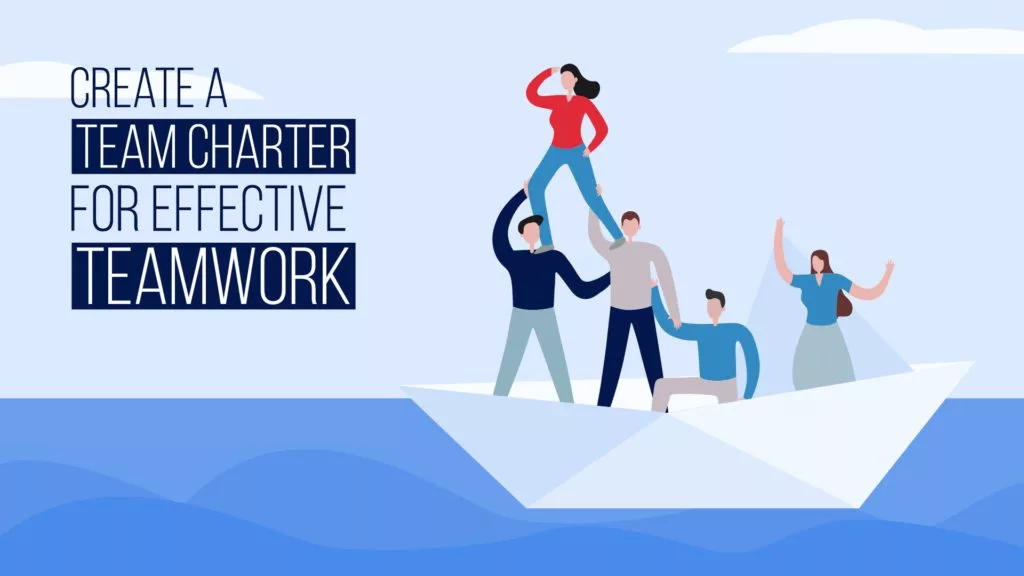
16 Sep, 2022 | SlideUpLift
Create A Team Charter For Effective Teamwork
Working in a team can be both rewarding and tricky. Ensuring that everyone in the team is working towards a common goal, collaborating and communicating progress, and delivering results is

11 Mar, 2021 | SlideUpLift
Wheel Of Change – The Perfect Model for Change Management Strategy
The world of business is constantly evolving. Traditional processes are being abandoned, as newer business models are created and adopted. With COVID-19 the pace of these changes has accelerated at

20 Feb, 2024 | SlideUpLift
Detailed Guide For Start Stop Continue Retrospective [With Examples & Exercises]
A lot of people find it challenging to provide and accept constructive criticism. Why? Because receiving criticism can be awkward. It might be uncomfortable to criticize your team's performance, and
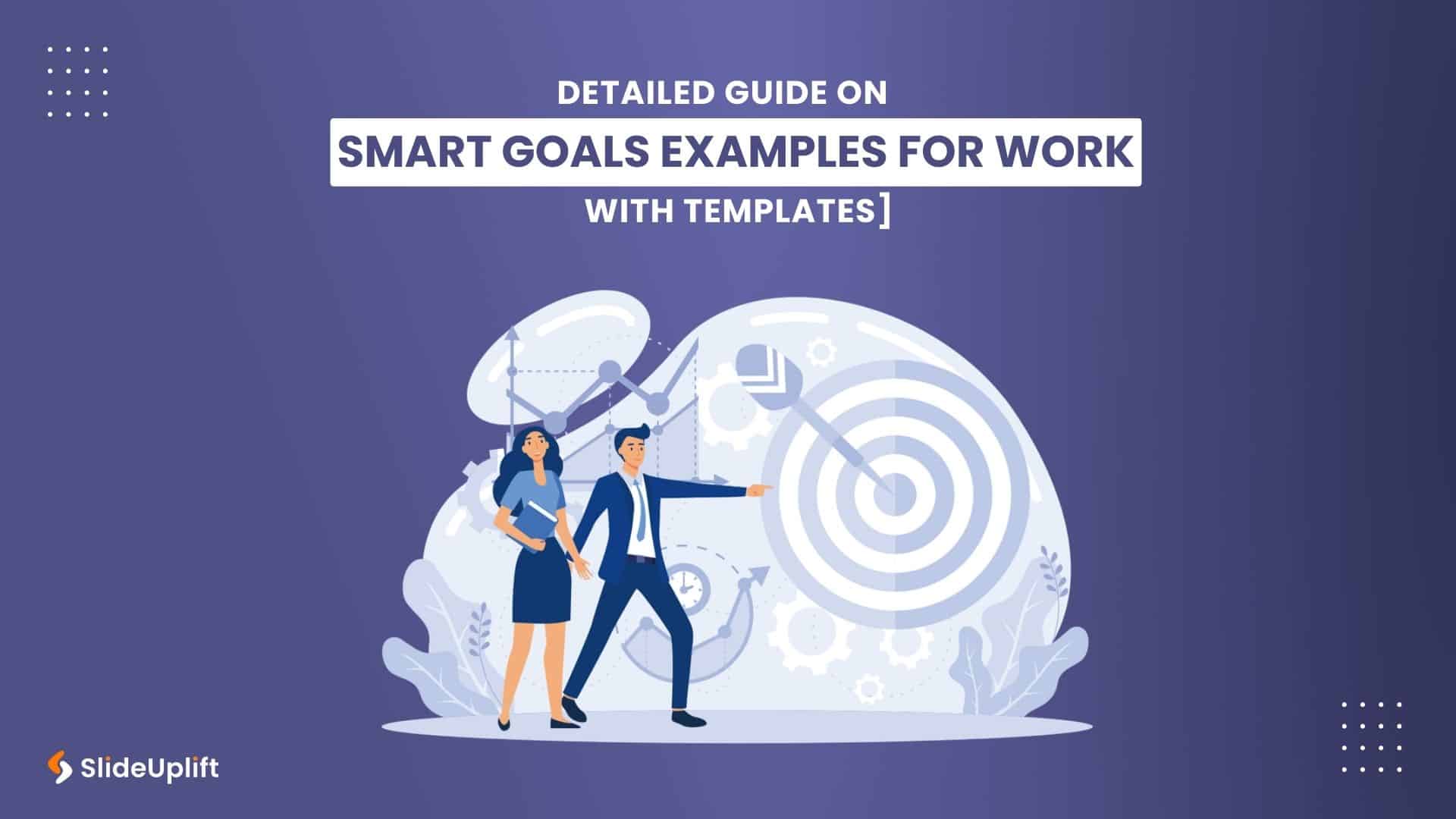
2 Feb, 2024 | SlideUpLift
SMART Goals Examples For Work [Guide For Professionals With Templates]
As we step into the fresh year of 2024, it's time to set resolutions for both our personal and professional lives. This includes taking a close look at our business
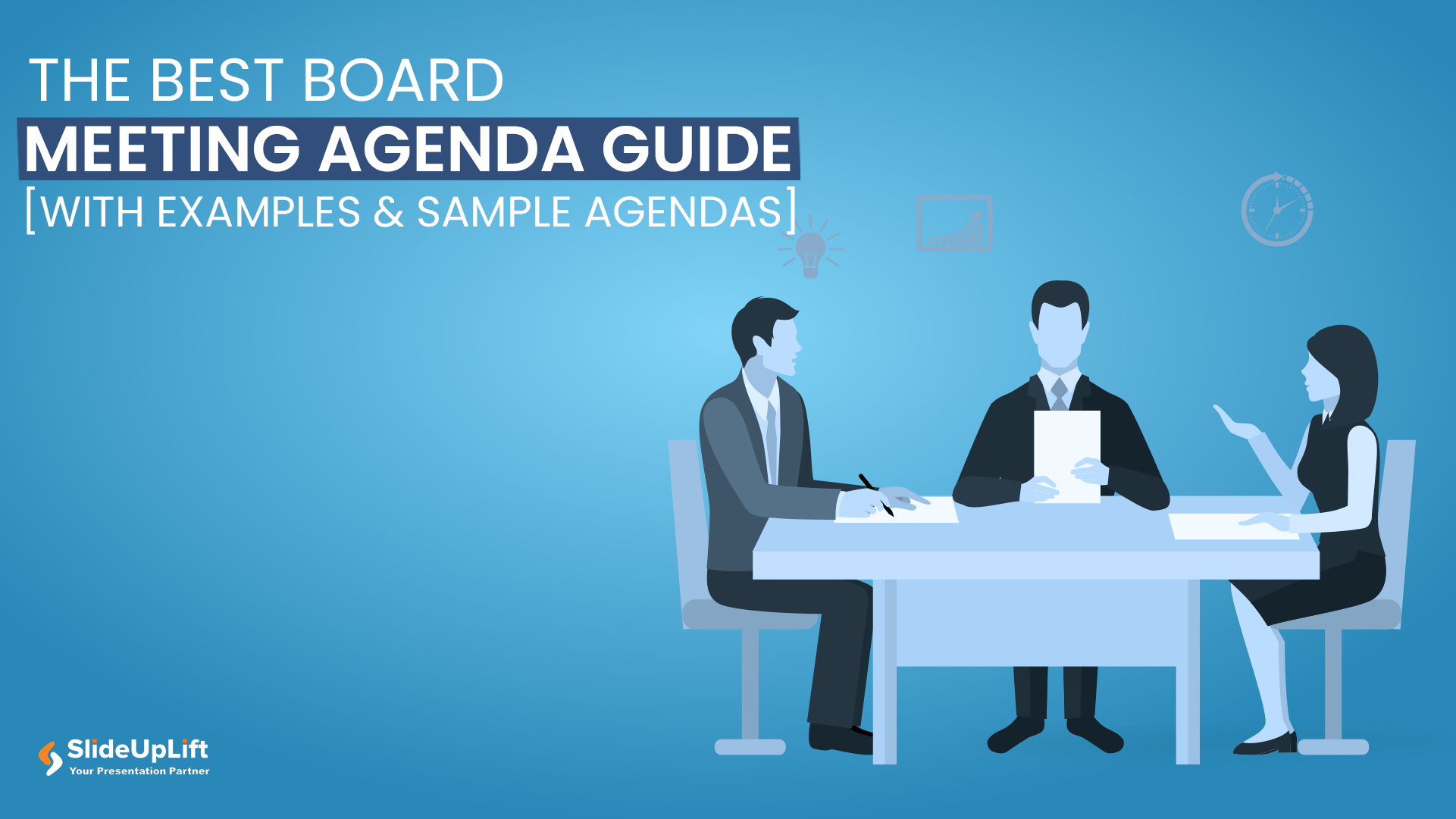
1 Feb, 2024 | SlideUpLift
The Best Board Meeting Agenda Guide [With Examples & Sample Agendas]
You might have had a meeting that went completely off. It might be overly prolonged and had numerous off-topic discussions. It has happened with most professionals at some point in

11 Sep, 2023 | SlideUpLift
Complete Guide to Outsourcing PowerPoint Presentations
The importance of compelling presentations cannot be emphasized. They serve as channels for exchanging knowledge, influencing choices, and communicating ideas. A well-designed presentation can influence perceptions, motivate action, and boost

6 Mar, 2024 | SlideUpLift
Best Work Plan Templates For Easy Task Organization [With Examples]
A project's success depends on having a detailed task plan. How can you perform tasks without having a plan for them? You and your team can produce the ideal work
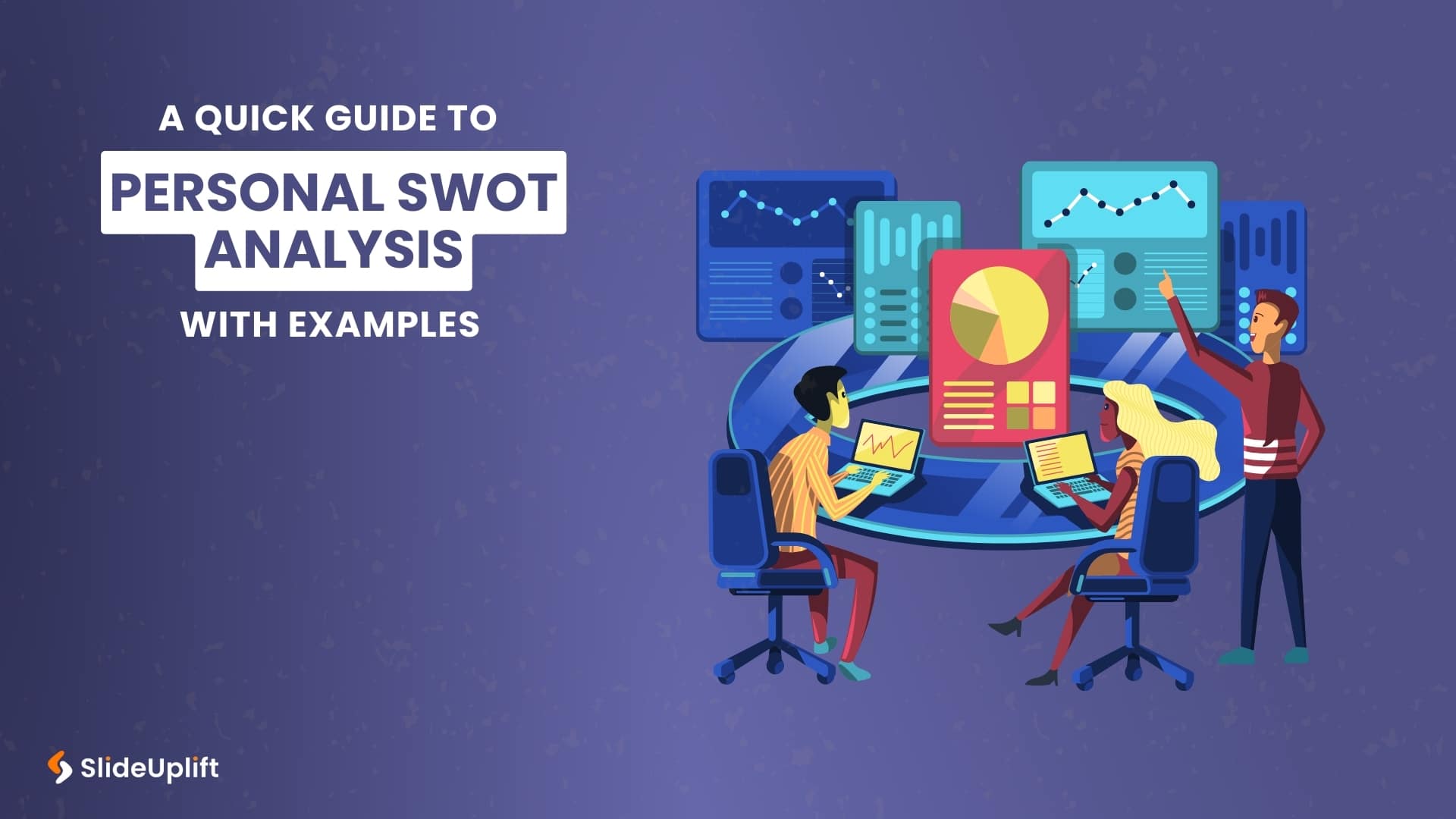
14 Feb, 2024 | SlideUpLift
A Quick Guide To Personal SWOT Analysis With Examples
How often have you faced the dreaded question in an interview: What are your weaknesses? Or what are your strengths? Many individuals find these questions intimidating because they fear it
Related Tags And Categories
Forgot Password?
Privacy Overview
Necessary cookies are absolutely essential for the website to function properly. This category only includes cookies that ensures basic functionalities and security features of the website. These cookies do not store any personal information
Any cookies that may not be particularly necessary for the website to function and is used specifically to collect user personal data via ads, other embedded contents are termed as non-necessary cookies. It is mandatory to procure user consent prior to running these cookies on your website.
Interview presentation preparation tips
The interview presentation is becoming more common in the hiring process. It gives employers a better overview of your general aptitude and provides you with an opportunity to showcase your skills, knowledge, and experience. But how should you prepare for an interview presentation? What should you include? What if it goes wrong?

4th Jun, 2021

On this page:
Stay up to date with the latest employer insights & events.
By submitting this completed form to us, you agree to Reed contacting you about our products and services, and content that may be of interest to you. You can unsubscribe from these communications at any time. For more information, please see our privacy policy .
By clicking submit below, you consent to allow Reed to store and process the personal information submitted above.
What is an interview presentation?
As you progress further in your career, particularly to executive level, you may be asked to give a presentation for interview. Perhaps you’ve been asked to conduct research and present your findings to a panel, complete a task and show how you approached it, put together a business plan and present your ideas, or even give a presentation about yourself and how you would excel in the role. Whatever you are presenting about, how you approach it should remain the same.
Many people find giving presentations intimidating, especially during an interview when you’re already nervous, but it’s something that you may have to do throughout your career – the sooner you tackle this skill, the better.
Why are you being asked to do a presentation for a job interview?
Many employers opt for a presentation-style interview as it gives a better overview of your general aptitude when compared to, or combined with, a traditional question and answer interview, like a competency-based interview . The interviewer is looking for proof that you can do the job and that you possess the required skills and traits.
Additionally, if you put time and effort into your presentation, this will highlight to the hiring manager that you are committed to the role and enthusiastic about joining the company. How many times have you been asked in an interview ‘Why do you want this position?’ or ‘What is it about this role that attracted you to it?’. They want to know how much you want this position, rather than just any position.
How to prepare a presentation for an interview
Where do you start? What should you include? The presentation is your opportunity to showcase your knowledge, experience, and communication skills as well as your organisational skills and diligence – so start with the job description and person specification and pick out key skills and traits that the company is looking for. Then you can prepare your presentation around what they want to see.
For example, if the business is looking for someone creative, pay great attention to the style of your presentation. If it is looking for someone who is a confident public speaker, spend more time perfecting your speech. If attention to detail is paramount in the role, double and triple check your spelling and grammar. This is a great starting point and gives you something to build your presentation around.
What to include in an interview presentation
Although you may be tempted to go all out and show your potential employer that you are committed to the job, don’t fall into the trap of creating a 30-slide presentation with reams of text. Try to keep each slide short and significant and aim for no more than 10 slides. This ensures the information you deliver is memorable and will help you to stand out from other interviewees. Some interviewers may even give you a specific amount of time for your presentation, make sure you factor this in and don’t go over the time limit – otherwise you may appear to have poor time management skills.
Another way to make sure your presentation engages hiring managers is to include a range of formats to help you illustrate your points. Include graphs, statistics, diagrams, video clips, and images to help break up large volumes of text and maintain the attention of the interviewers.
If you are conducting research as part of your presentation, include quotes from industry leaders and/or research pieces. This gives your points authority and demonstrates your commercial awareness.
You should also try to incorporate the company’s colours, fonts, or style in your presentation. This will show that you have done your research and highlights your brand awareness.
Finally, check your spelling and grammar thoroughly! Small mistakes can really undermine the content of your presentation.
Tips for presenting at the interview
Presenting is a skill which can be learnt. Even if you are not a confident public speaker, the more you practice, the better you will become.
Present confidently and enthusiastically - Remember to speak clearly, make eye contact, and use open body language.
Don’t just read the slides - There is nothing worse than watching a presentation where the presenter has their back to you the whole time just reading reams of text from their PowerPoint notes.
Try not to talk too fast - Make sure you breathe, and take your time.
Practice, practice, practice - Ensure you are well rehearsed so that you are familiar with the structure of your presentation and are able to deliver it smoothly. If possible, practice your presentation with family members or friends to get used to speaking in front of other people.
Arrive early to give yourself time to set up the presentation and settle any nerves - Get comfortable with PowerPoint and presentation equipment. Make sure you know how to work any projectors, screens, or remote controls before you begin to avoid any awkward stumbles or pauses.
Stay within the allocated time - If you have not been given guidance on length, aim for the 10-minute mark. Time your presentation when you are practising to make sure it will fit within the time limit. If you need to reduce the content of your presentation, cut out the least relevant or weakest points.
Be prepared to adapt - You may have practised your presentation in a certain way, but the interviewer might not respond accordingly. Be prepared to be interrupted by questions or further discussion unexpectedly.
Breathe and try to enjoy it - By relaxing, you will find yourself presenting better and, if you enjoy it, your interviewers will respond to that and be better engaged with what you are saying.
Tips for keeping the interview presentation simple
It can take a lot of work to make something simple, yet effective, and when it comes to interview presentations less is often more. Keep it short - As previously mentioned, try to keep each slide short and aim for no more than 10 slides in total.
One idea per slide - To make sure your presentation is clear and concise, each slide should represent a different point/idea you want to make.
Stick to the important bits only - If you don’t think it’s important enough to spend time on, don’t have it on your slide.
Use the 4x6 rule - Aim for either four bullet points with six words per bullet point, or six bullet points with four words per bullet point. This way, your slides won’t look too busy.
Minimal text - Instead of writing paragraphs of text, use bullet points and a minimum font size of 24.
What's better for your interview presentation? Cue cards or presenting from memory?
Should you use cue cards in your presentation for interview or try to present from memory?
The answer to this question depends on what you feel most comfortable doing. If you find that having cue cards will help ease your nerves and ensure that you don’t forget your speech, then there is nothing wrong with that.
However, if you choose to use cue cards, you should not rely too heavily on them. You shouldn’t stand in front of the interviewers and look down at the cards continuously, neither should you write your whole speech out on the cards and read directly from them. They are cue cards for a reason and should only give you prompts on what to talk about. If your interview presentation has a lot of statistics on, using cue cards to remember the figures if you are unable to memorise them all is an excellent strategy.
What to do when things go wrong
You can practice your interview presentation as much as possible, but something may still go wrong and it’s important to be prepared for this eventuality. Here are some things that could go wrong and how to deal with them: Technical issues
There is not a lot you can do to prevent technical issues, especially if you are using someone else’s computer. But there are ways you can prepare just in case. Ensuring you have access to multiple sources of your presentation is key. Email the file to yourself and the recruiter, bring a copy on a USB stick and printed handouts. This way you are covered if anything goes wrong with the file you’re intending to use.
Your mind goes blank
Even those who are pros at presenting can sometimes lose their train of thought and find that their mind goes blank. The key here is not to panic. If possible, take a bottle or glass of water in with you and use this chance to take a sip, breathe and try to relax. Then look at your presentation slide or your cue cards and pick up where you left off. It may be helpful to repeat the last point you made as saying it out loud could spark your memory for your next point.
You are asked a question that you don’t know how to respond to
If you have allotted time at the end of your presentation to allow the interviewer to ask any questions (which is recommended), don’t worry if someone asks a question that you are not sure on. It may be that the interviewer is looking to see how you respond to a challenging question, so how you react is often more important than the answer itself.
If you do not understand the question, ask the person to explain. There is nothing wrong with doing this and shows more confidence than just saying that you don’t know. If you understand the question but are not sure of the answer, then admit that you don’t have the full answer, provide what information you do have, and offer to come back to them at a later date with a complete answer.
10-minute interview presentation template
Below is a presentation for interview example. Use this as a baseline and adapt or reorder where appropriate based on the task you have been set by the interviewer. Slide 1 - Introduction – Reiterate the objectives you have been set and lay out the structure of your presentation so that the interviewers know what to expect. Slide 2 - About you – Detail your professional experience, skills and working style. Slide 3 - Company history – Give a brief summary of the company history, any milestones or awards. Slides 4-7 - Answering the brief – Give your responses to questions you’ve been asked to answer, the benefits and limitations of your suggestions. Slide 8 - Question and answers – Include a slide titled ‘questions and answers’ as a cue to pause for interaction. Slide 9 - Conclusion – Sum up the key points you have made, reach a decision, and explain your reasoning. Slide 10 - Personal achievements – End the interview on a high with a brief slide highlighting achievements that show how you will succeed in the role.
For more information on how to ace your interview, download our free guide, ‘ Getting the best from your interview: Candidate interview tips and tricks ’, or contact your local recruitment specialist today.
You may also be interested in...

Getting the best from your interview
The interview is about presenting yourself as the best candidate for not only the position, but the company. Our handy guide will take you through some simple steps to make sure you do just that.

The eternal optimist - winning with an attitude of gratitude
Former England sevens Captain and current PwC Director, Motivational Speaker, Coach & Founder of Optimist Performance, Ollie Phillips, gives you an insight into becoming an ‘eternal optimist’.

How to prepare for a second interview
How to write a covering letter. The bane of many people’s lives. But it really doesn’t need to be. Follow our simple tips and yours will stand out from the crowd.
Frequently Asked Questions
A job interview presentation is all about selling yourself. Be confident, speak clearly, and make eye contact with the interviewer. Don’t be afraid to promote yourself and highlight your achievements. This is your chance to really show the interviewer that you are capable and have the necessary skills to do the job. By putting time and effort into your presentation, you can show them how dedicated you are to the role and the company. For more information on how to ace your interview, download our free guide, ‘ Getting the best from your interview: Candidate interview tips and tricks ’.
Using cue cards can support you with your interview presentation, as long as you use them for their intended purpose. Do not write your entire presentation for interview out on cards and read from them word for word or constantly hold them in your hand and fail to make eye contact with the interviewer. Use them only to prompt you or for remembering key facts and figures. For more tips, read our article on ‘interview tips & questions’ .
If you have been sent a presentation brief that you do not understand – don’t panic. If there are words that you are not sure about, do some research and try your best to figure out what the organisation is asking of you. If you are still unsure, you could ask your recruiter as they may have seen this brief before and can give you an idea. If you are dealing directly with the hiring manager, then it may be worth checking that your interpretation of the brief is correct.
It is better to ask the question than present on something completely different to what the interviewer has asked. However, instead of saying to them that you don’t understand the brief and leaving it at that, tell them your understanding of it and ask if this is correct. This will show that even though you are unsure, you have taken the time to try to come to a conclusion yourself before asking for help. Download our free interviewing guide for more tips and advice.
How long your job interview presentation should last depends on what guidance you have been given. Thoroughly read the brief, as the recruiter or hiring manager may have specified the length of time you have for your presentation. If they haven’t given any indication, you should aim for 10 minutes, including time for questions and answers. For more tips on interviewing, read our article on ‘interview tips & questions’ .
Find a Reed office
Our national coverage allows us to offer a recruitment service tailored to your needs, with accurate local market intelligence on salaries, competitors and the best professionals who can help your business thrive.
How to Prepare a PowerPoint Presentation for Job Interview Success
Preparing a PowerPoint presentation for a job interview involves summarizing your skills, experiences, and value proposition in a visually appealing way. You’ll need to plan your content, design your slides, and practice your delivery to ensure you make the best impression.
After completing your PowerPoint presentation, you’ll have a powerful tool to help you stand out in the interview process. It will demonstrate your proficiency with technology, your ability to communicate effectively, and your readiness for the role.
Introduction
When it comes to job interviews, first impressions are everything. In today’s competitive job market, candidates are constantly looking for ways to distinguish themselves from the pack. One effective method is to create a PowerPoint presentation to showcase your skills, experience, and qualifications. Whether you’re applying for a position that requires technical skills, creative thinking, or leadership abilities, a well-crafted presentation can help you demonstrate your expertise in a dynamic and memorable way.
PowerPoint presentations are not only for showing your previous work or the projects you’ve been part of. They’re also a platform to illustrate your thought process, your approach to solving problems, and your ideas for contributing to the potential employer’s success. For professionals in all fields, from marketing to engineering, a PowerPoint presentation can serve as your visual aid and personal brand ambassador. Let’s dive into the steps to craft a presentation that could very well tip the scales in your favor.
Step by Step Tutorial: Preparing a PowerPoint Presentation for a Job Interview
Before we start, remember that a PowerPoint presentation for a job interview should be concise, relevant, and engaging. Here’s how to create one that’ll help you nail the interview.
Step 1: Define the Objective of Your Presentation
Identify what you want to achieve with your presentation.
Before opening PowerPoint, take a moment to think about the message you want to convey to your interviewers. Are you aiming to showcase your expertise, outline your experience, or present a case study? The objective will guide the content and structure of your presentation.
Step 2: Research the Company and Role
Tailor your presentation to the company and position you’re interviewing for.
Understanding the company’s culture, values, and challenges allows you to tailor your presentation accordingly. Highlight experiences and skills that align with what they’re looking for. Use the company’s color scheme or logo to personalize your slides and show that you’ve done your homework.
Step 3: Plan Your Content
Outline the key points you want to cover in your presentation.
Create an outline of what you’re going to talk about. Start with an introduction about yourself, followed by your relevant experiences, accomplishments, and conclude with how you can contribute to the company. Keep it simple—three to five main points should suffice.
Step 4: Design Your Slides
Create visually appealing slides that reinforce your message without distracting from it.
Use a clean, professional design with plenty of white space. Stick to a few key colors and use high-quality images or graphics. Make sure the text is large enough to be easily read, and don’t overcrowd your slides with too much information.
Step 5: Practice Your Delivery
Rehearse presenting your PowerPoint to ensure a smooth delivery on the day of the interview.
Practice makes perfect. Rehearse your presentation several times to get comfortable with the flow and timing. Anticipate questions you might be asked and prepare answers. The more you practice, the more confident you’ll be during the actual presentation.
Additional Information
When preparing your PowerPoint presentation for a job interview, it’s important to remember that less is more. Keep your slides clean and uncluttered, using bullet points rather than paragraphs of text. Use graphs, charts, and images to illustrate your points visually, as these can be more impactful than words alone.
Be mindful of the time constraints you might have during your interview and design your presentation accordingly. Aim for no more than 10-15 slides, each covering a single topic or idea. It’s also a good idea to prepare a leave-behind, a printed version of your presentation or a summary document that you can give to your interviewers for later reference.
Remember, the goal of your presentation is to supplement your spoken responses, not replace them. Use the slides to emphasize and enhance what you’re saying, not as a script to read from verbatim.
Lastly, make sure to weave in your personality throughout the presentation. This is your chance to make a connection with your audience, so let your passion and enthusiasm for the role shine through.
- Define your presentation’s objective.
- Research the company and role.
- Plan your content efficiently.
- Design visually appealing slides.
- Practice your delivery thoroughly.
Frequently Asked Questions
How many slides should my presentation have.
Aim for 10-15 slides to keep your presentation concise and impactful.
Should I bring a printed version of my presentation?
Yes, providing a printed summary or leave-behind is always a good idea.
Can I use animations in my presentation?
Use animations sparingly and only if they add value to your presentation.
How can I avoid technical issues during the presentation?
Always have a backup plan, such as a PDF version of your presentation on a USB drive.
Is it appropriate to ask if I can present a PowerPoint during my interview?
Yes, it’s best to confirm with your interviewer beforehand if they welcome a PowerPoint presentation.
Preparing a PowerPoint presentation for a job interview is a strategic move that can set you apart from other candidates. It’s an opportunity to demonstrate your skills, knowledge, and passion for the role. By following the steps outlined in this article, you can create an engaging and informative presentation that will impress your potential employers and increase your chances of landing the job.
Remember, the key is to be prepared. Research the company, plan and design your slides carefully, and practice your delivery. With a well-crafted PowerPoint presentation, you’ll be able to showcase your best self and leave a lasting impression. So, go ahead and give it your best shot—your dream job awaits!

Matthew Burleigh has been writing tech tutorials since 2008. His writing has appeared on dozens of different websites and been read over 50 million times.
After receiving his Bachelor’s and Master’s degrees in Computer Science he spent several years working in IT management for small businesses. However, he now works full time writing content online and creating websites.
His main writing topics include iPhones, Microsoft Office, Google Apps, Android, and Photoshop, but he has also written about many other tech topics as well.
Read his full bio here.

Share this:
Join our free newsletter.
Featured guides and deals
You may opt out at any time. Read our Privacy Policy
Related posts:
- How to Save Powerpoint as PDF with Notes
- Can I Convert My Powerpoint to Google Slides?
- How to Drag Slides From One PowerPoint to Another: A Step-by-Step Guide
- How to Make a Powerpoint Slide Vertical in Powerpoint 2013
- How Is Microsoft PowerPoint Used in Business: A Comprehensive Guide
- How to Set Time for Slides in Powerpoint
- How to Change Hyperlink Color in Powerpoint 2010 (An Easy 5 Step Guide)
- How to Insert Slides from Another Presentation in Powerpoint 2010
- Microsoft Excel Skills to Know When Job Hunting
- How to Unhide a Slide in Powerpoint 2013
- How to Check Word Count on Powerpoint 2010
- How to Change the Font on All Slides in Google Slides
- How to Convert a PowerPoint to Word and Edit with Ease
- How to Loop a Slideshow on Powerpoint 2013
- How to Change Line Spacing in Powerpoint for Every Slide at Once
- What Are Benefits of PowerPoint? A Comprehensive Guide
- How to Email a PowerPoint Slideshow: A Step-by-Step Guide
- How to Combine PowerPoint Presentations With Different Orientations
- How to Copy a PowerPoint to a New PowerPoint: A Step-by-Step Guide
- How to Delete Multiple Slides in Google Slides
- InterviewPenguin.com – Your best job interview coach since 2011
Demonstrate Your Skills in an Interview with a PowerPoint Presentation
Extra effort brings extra results . Everything you do before, during, and after your interview, matters at the end of the hiring process. To prepare a PowerPoint presentation is definitely a good idea–especially when you can use it to demonstrate your knowledge of the job , or to showcase a successful project which you completed . Job seekers typically prepare one of the following presentations:
- Work portfolio – the presentation gives a brief insight on your career, the jobs you’ve had, the projects you managed, and the things you achieved and learned while working on them. Portfolio is especially useful for people who apply for technical jobs, such as graphic designer, project manager, web developer, application developer, marketing manager, cook , etc.
- Presentation of a specific project – for example if you apply for job in software development company, you can prepare a PowerPoint presentation of one of the projects you led. From first draft and planning of the application through setting milestones to completing them. Such a presentation helps you to demonstrate your excellent pm skills.
* Do not forget to check also: Project Manager Interview Questions .
Table of Contents
Ask them whether you can use a presentation
A presentation is an effective way of demonstrating your skills, and if you do it in a right way, you will benefit from having it in an interview. Nevertheless, you should always ask the interviewers whether you can do the presentation.
Many hiring managers have their own way of doing things, they follow a strict interview template with each job candidate, and they have a packed schedule from morning to evening. In such a case may not allow you to show your presentation–simply because they want to follow the very same interview template with each job candidate –either everyone shows their PowerPoint presentation, or no one will.
Bearing this in mind, you should call them before the interview and ask about an option to show the PowerPoint presentation. Remember that even if they do not allow you to do it, they will appreciate the idea , and the extra effort you made to prepare something for your interview. All HR managers love the “I do more” attitude.

How to prepare a presentation
From a software point of view, you will find good tutorials on YouTube , and learn how to prepare a great-looking PowerPoint presentation with ease. From the content point of view, check our interview portfolio article to understand what you should include on your presentation, and what you should rather avoid.
Practice makes perfect, bad presentation can kill your chances
It happened to me several times that a job applicant brought their laptop to the interview, and they delivered their presentation. We did not agree about this upfront, but I never follow a strict template in job interviews, and I like applicants that do something more while trying to succeed. Therefor I let them to deliver the presentation.
More often than not, however, the presentation had very little to do with the job offer. Or, even worse, the way they delivered it uncovered their weaknesses in terms of their communication, presentations, or project management skills. Take my advice: Practice your presentation before an interview, and make sure that it relates to the job you try to get. Honestly, no presentation is better than a bad one.
Do not put us under pressure, let us lead the interviews
Most interviewers have an exact schedule for their interviews, and the template, and they try to follow both of them. You should not interrupt them at the beginning and tell that you want to present your portfolio, or certain project with the help of MS PowerPoint.
You should wait for a good time , and a good time comes when:
- We ask about your working experience.
- At the end of the interview, when everything else has been said and done.
- When they ask you a practical question, and the answer can be explained with the help of your presentation (this is actually the best time to suggest doing it).
Conclusion and next steps
Wait for the right time. It may come, and it may not come. Maybe everything goes well, and you won’t even need the presentation to get a job . Do not press the issue, do not try to do the presentation at all costs.
If you get a chance to show us your presentation, ensure that the content relates to the job offer, and demonstrates the value you can bring to our company. Practice your presentation beforehand , and ensure you’d deliver it in a best possible way–showing your strong presentation and communication skills.
While the presentation can help you greatly with your efforts to get a job, other things matter as well in an interview. Let’s prepare for them together:
- How to answer interview questions – Not only WHAT you say, but also HOW you say it matters in an interview.
- Salary negotiation tips – Learn how to get the best possible salary offer at the end of your job interview.
- How to overcome interview nerves – Feeling anxious before your interview? You are not alone, and we will show you how to solve this problem.
- Recent Posts
© InterviewPenguin.com
Privacy Policy
- Google Slides Presentation Design
- Pitch Deck Design
- Powerpoint Redesign
- Other Design Services

- Guide & How to's
How to create and give a great presentation at a job interview?
A job interview presentation can be your own initiative or the company’s requirement for meeting with HR or a recruiter. In both cases, it is your chance to demonstrate your mind, approach, and skills from your vacancy perspective. Additionally, a quality and attractive interview PowerPoint presentation shows your ability to analyze, talk, explain, and persuade. If you’re a designer, you should make a pitch on colors, fonts, and other visual components. If you are a sales manager, you should concentrate on numbers and better send a presentation design to the agency.
If you feel you can rely on yourself, we’d like to share some tips on how to make a presentation for an interview and present it confidently.

Slides to Include in an Interview Presentation PPT
The zero advice here is to include only the most relevant details and facts of your biography. If you apply for a manager position, mentioning psychology as a hobby will add points. However, if you apply for a programmer, there is no need to show your rewards in ballet or box.
To begin with, aim for one slide per minute. If given 10 minutes, try to contain 10 to 12 slides. Let’s outline some basic slides in your presentation for the interview ppt.
All these slides cover a simple 3-stage presentation structure:
- Introduction: tell them what you’re going to tell them.
- Middle: tell them.
- End: tell them what you told them.
Slide 1: Welcome the audience.
Welcome people to your presentation by introducing them, saying what you will cover, assuring their comfort as observers, and asking them to leave all questions until the end.
Slides 2-3: About me (education, past jobs, courses, skills).
Slides 4-5: What I can do for you (the reason to apply, strengths, previous achievements).
Slides 6-7: Why I can do it (skills, solutions).
Slide 8: Summary.
Some positions allow including slides about hobbies or some interest outside the work, but we suppose that depends on the seniority of your position and its type. If those interests strengthen your skills required, add them but briefly.
Tips to Improve Your Presentation for Interview
Research the company.
The first interview presentation tip is to personalize slides for the company’s industry and their latest challenges/news/issues. What kind of products and services do they sell? You adjust your expertise to the company’s current problems showing how your skills impact and contribute as soon as they hire you. However, we advise not adding these references to every slide because it may look obsessive.
Know yourself
The second tip to ace your interview presentation slides is to know your strengths. You can list dozens of certifications, but how do they really work and help in practice? Name advantages related to the company. Tell the audience what you have done and can do to assist the company in current challenges. For example, you’ve researched the company’s goals to achieve, and you should focus on those strengths that complement these aims.
Present with PCS format
PSC is an abbreviation meaning Problem, Consequences, and Solution. For example, you start the presentation by identifying a company’s problem, continue with the consequences they face without your expertise, and end with the clear solution you propose to overcome the problem. The solution shouldn’t be perfect, but this approach shows you’re a creative problem-solver.

6 C’s to Consider to Give Top-Notch PowerPoint Presentation for Job Interview
Psychologically, you need to do a couple of preliminary things to recognize what interviewers are looking for in the first place. Let’s review what they specifically search:
1. Communication
They will look at how you communicate, articulate, or are cohesive and smooth. Not only slides but words coming out of your mouth must make sense.
2. Carry yourself
They will notice whether you’re enthusiastic, energetic, polished, professional, persuasive, etc. For example, if you apply for a senior position, the interviewer will definitely consider if you can give confident pitches or arguments.
Are you comfortable with this entire environment? Is it easy for you to be present? People who interview dozens of candidates easily read your comfort or discomfort level by analyzing body gestures: how you click the clicker, look at the slides, bite lips, change voice tone, react at the interruption, etc.
4. Construction of presentation
It is more than just an outline structure, and it is about whether the person is going through a cohesive story with all the necessary information and prepared slides. It is about the packaging you must put together from PowerPoint or Google slides , a deck, handouts, etc.
It is the biggest key of the whole meeting. Sure, presentations are about introducing yourself, but the insight, information, and sequencing will cover the most time.
6. Compelling
You’ll often need to make a persuasive argument for the audience to see it as a good “deal” and you as a profitable “offer” they want to buy. Don’t consider it offensive but aren’t you selling your expertise and time, right?
To get the offer, you need to know what they want to give something valuable. People make mistakes when they think about their personalities while creating slides. The right approach is to consider the company’s needs when compiling skills, adding certifications, and listing advantages. Don’t waste anyone’s time 🙂
If you consider our tips, you know now how to give a good interview presentation. It is all about focusing on the company’s current needs or challenges. If you use this perspective, you’ll look like a more valuable candidate interested in the vacancy and able to propose solutions to real problems and ways to achieve current goals. Companies will never kick off individuals who know their strengths, communicate confidently, and show sincere interest in the company.
#ezw_tco-2 .ez-toc-widget-container ul.ez-toc-list li.active::before { background-color: #ededed; } Table of contents
- Presenting techniques
- 50 tips on how to improve PowerPoint presentations in 2022-2023 [Updated]
- Keynote VS PowerPoint
- Types of presentations
- Present financial information visually in PowerPoint to drive results

How to write a resume presentation: tips and tricks from experts

- Design Tips
How to make a presentation interactive

Inspiration for PPT: how to find design ideas
Subscribe to get notified about product launches, special offers and news.
Free shipping on orders over $9.99 within the continental US
Login to my account
Enter your e-mail and password:
New customer? Create your account Lost password? Forgot your password
Forgot Password
Enter the email address associated with your account.
Remembered your password? Back to login
Create my account
Please fill in the information below:
Already have an account? Login here
Located in Huntsville/Madison, AL? Request a Business account here
Your cart is empty
How to Nail a PowerPoint Presentation for Job Interview
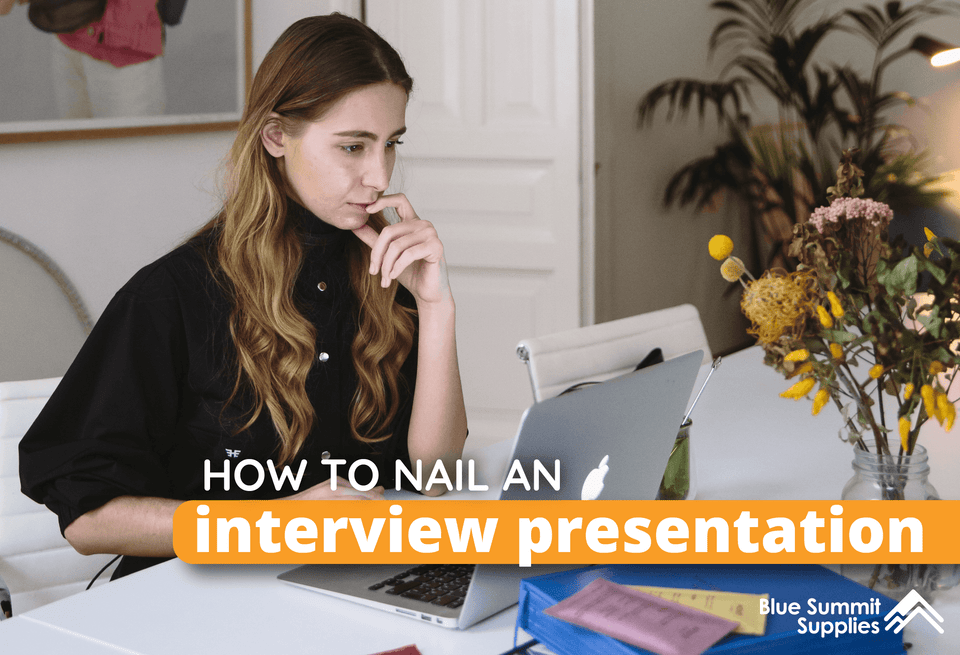
You just scored an interview for you dream job! Yes! But…now they’re asking you to give a PowerPoint presentation for the job interview.
What the heck? Isn’t interviewing nerve-wracking enough without the added stress of giving a presentation?
We hear you. It’s a lot of stress. But actually, when you stop to think about it, what is a job interview if not a presentation about yourself? Now you just have the added benefit of visuals and slides to work with.
In this article, we’ll demystify the interview PowerPoint presentation ordeal and help you put your best foot forward so you can nail the interview!

What is an Interview Presentation?
Ok, back up. What exactly is an interview presentation? According to Indeed , an interview presentation is a “formal presentation delivered to a human resources team, management team, or another group of people to convince them that you are the best candidate for a position.” Potential employers may ask you to make an interview presentation to better assess your public speaking and/or communications skills, your ability to stay calm under pressure, your knowledge about specific, industry related topics, and more.
This kind of presentation can give your potential employers a really comprehensive look at you, so it makes sense. And although you may run into a request for an interview presentation in any industry, this tact is particularly popular in Sales, Marketing, Technology, and Academia.

Benefits of Interview Presentation
Now that you know why employers might make this request, why might an interview presentation be a good thing for you? One of the biggest benefits for you is that it gives you a chance to shine and stand out. Old-fashioned interviews have become somewhat run-of-the-mill, with those ever-recycled questions like “what would you say are your greatest strengths” all running together. But with a unique presentation designed and delivered by you, there’s more of a chance for you to really leave a distinct impression.
Additionally, giving an interview presentation gives you a chance to show your professionalism in a different setting than just a conversation. You can prove your diligence, your attention to detail, and your work ethic just by how you compile the presentation.
How to Make an Interview Presentation
It may seem overwhelming at first, but don’t be intimidated by the task of creating an interview presentation. Below, we’ve compiled a list of interview presentation tips — from initial research to the final presentation — that will have you acing this task in no time.
Making the Presentation

Gather Information

Do your Research
This is a solid tip for any kind of interview: do your research! Make yourself an expert on the company for which you are interviewing. It’s no secret that you are far less appealing as a potential hire if you don’t know anything about the company or industry. But the important thing here is to make sure your gathered knowledge comes across. Prove your expertise in your presentation.

Pick your Platform
Sometimes, your potential employer will have a particular platform that they want you to use for your interview presentation, but more than likely, they will leave it up to you. The basic presentation software out there includes PowerPoint, Keynote, and Google Slides. If you’re going for an artsier, more unique approach, check out Prezi : an online virtual presentation tool with a more animated feel. Go with whatever platform you’re comfortable with, or you can even start by looking at templates and seeing what matches your style.

Start with Structure
Every great presentation, whether for an interview or not, starts with a strong and compelling structure. In simplest terms, you have an opening, details, and then a conclusion. When structuring your presentation, begin with a strong opening that states your goals and introduces yourself. Next, keep the main body of the presentation to around three major points (although you can have plenty of subsections.) Then finish with a killer closing, something to bring it all home. All throughout, keep your message clear and make every piece of your presentation relate back to that message.
Check out this article for more in-depth tips on structuring a great presentation of any kind.
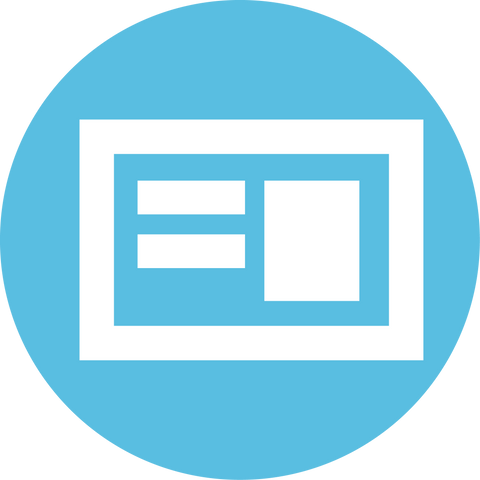
Keep it Clear, Succinct and Impactful
Make sure your content is simple and clear. You want your audience to glance quickly at your slide, gain interest, and then listen to you, the presenter, for more in-depth information. Be careful not to pack too much information onto the slides themselves, or to break off onto tangents that don’t support you. But do be sure to choose eye-catching images for your slides and easy-to-read fonts that really pop.

Highlight YOU
You could almost think of this presentation as a commercial and the product you’re selling is you. While it’s important to demonstrate expertise through your presentation, make sure that everything goes back to selling you as the star of the show.

Practice, Practice, Practice

Giving the Presentation

Build Rapport
The day of the interview is here! Once you begin your presentation, start off by building rapport with your audience. Not only will this help draw them in and make them more engaged in your story, it will also help calm you down. Introduce yourself, smile, and maybe even consider cracking a joke if the mood is right.

As you give your presentation, try your hardest to not read straight off the slides or from your notes. Snooze alert! This will bore your audience and give them the impression that you don’t know what you’re talking about. Be so confident and practice so thoroughly ahead of time that you can speak off the cuff and don’t need to read your notes at all.

Mind Your Body Language
Sit up straight, shoulders back, and smile! Your body language is always incredibly important for any kind of presentation. You want to appear professional and comfortable at the same time.

Diction and Delivery
Make sure you’re enunciating clearly and projecting to “the back of the room,” even if that’s just your computer’s microphone. If you mumble or speak too quietly, you’ll come across timid. Also, most of us have a tendency to speed up when we’re nervous. Pay attention to the pace of your speech and even build in some pauses if you can. This will give you time to collect your thoughts and let your message sink in for your audience.

Be Confident
You got this! Even if you’re not feeling confident on the inside, show it on the outside. Speak with authority and make eye-contact with your audience by staying focused on your camera. This is you you’re selling after all, and no one is a better authority on you than you!

Take Questions at the End

Presentation for Interview Example
If you’re looking for job interview presentation ideas, check out this great example on Slide Team or this one on Slide Geeks .

Pre-Recorded Video Interviews
On a related note, some potential employers may ask you to make a pre-recorded video interview. This tactic has become increasingly prevalent in the age of COVID and Zoom interviews. Essentially, employers can give you a set of questions ahead of time and you can record yourself answering them, then send it in for them to review on their own time. Sometimes, potential employers will call this a “pre-screening.” While this isn’t technically an interview “presentation” per say, it sort of falls into the same category, so we want you to be prepared.
The best way to record video interviews is with whatever software and setup you’re comfortable with! If you have a great camera-ring light-soundproof room already set up and raring to go, obviously you should use that. But if you don’t have a pro setup, don’t sweat it. Most people don’t. Just record your interview with the webcam on your computer. You can also record an interview directly through Zoom meetings . But do make sure that you are properly lit, somewhere quiet, and that your background is clean and intentional.
Other tips for pre-recorded video interviews:
- Maintain eye contact by focusing on the camera and not the video of yourself.
- Dress professionally , even your pants and shoes that won’t be seen in the video. You’ll be in a better headspace when you’re dressing the part and you avoid the embarrassment of accidentally standing up while only wearing boxers in the video.
- Remember — it’s still an interview! Don’t let the strange format throw you off. You still need to transfer everything you’ve learned about acing interviews, like not fidgeting and sitting up straight – to this pre-recorded format. Check out our article on acing remote interviews to learn more.
So by now, hopefully you feel like an expert on how to nail a presentation for a job interview. Once you understand what is being asked of you and how it benefits all parties, this type of interview makes a lot of sense. If you follow the guidelines above, you’ll be able to make a stellar presentation. And remember, your audience wouldn’t have invited you to interview if they didn’t see something in you. They want you to succeed! So take a deep breath and give a presentation that’ll knock their socks off!
Do you love office talk as much as we do? Follow our office supplies blog for the latest office trends, team building strategies, product comparisons, and more.
If you have any questions or want to talk to someone about office supplies, send us an email or connect with us on Twitter , Facebook , or Instagram .
For more informative articles about office supplies, subscribe to our email newsletter!
Never fear, you won't begin receiving daily sales emails that belong in a spam folder. Instead, we promise a fun weekly roundup of our latest blog posts and great finds from across the web. And if you lose interest, it's always easy to unsubscribe with a single click.

ABOUT THE AUTHOR
When Olivia West isn't writing theme park attractions for Universal and Disney, she's writing any other thing she can get her hands on! She loves writing novels, scripts, blog posts, bad jokes, and everything else. If you can't find her at her laptop, however, she might be chilling in the nearest speakeasy sipping a manhattan or screaming her head off on the nearest roller coaster. Check her out at oliviawestwriting.com !
Leave a comment
All comments are moderated before being published

Popular posts

Featured products
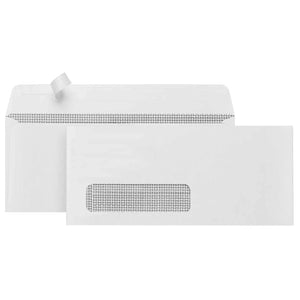
Free shipping for most
On orders $10 or more within the continental US
Customer Service
Check our FAQs or send us a message
Send us a message
We are available Monday through Friday, 8am - 5pm CST
Safe & secure payments
Our store is PCI compliant to keep your info safe
- Opens in a new window.

Powerpoint Templates
Icon Bundle
Kpi Dashboard
Professional
Business Plans
Swot Analysis
Gantt Chart
Business Proposal
Marketing Plan
Project Management
Business Case
Business Model
Cyber Security
Business PPT
Digital Marketing
Digital Transformation
Human Resources
Product Management
Artificial Intelligence
Company Profile
Acknowledgement PPT
PPT Presentation
Reports Brochures
One Page Pitch
Interview PPT
All Categories

Example Presentation For Job Interview PowerPoint Presentation Slides
Our Example Presentation For Job Interview PowerPoint Presentation Slides are topically designed to provide an attractive backdrop to any subject. Use them to look like a presentation pro.
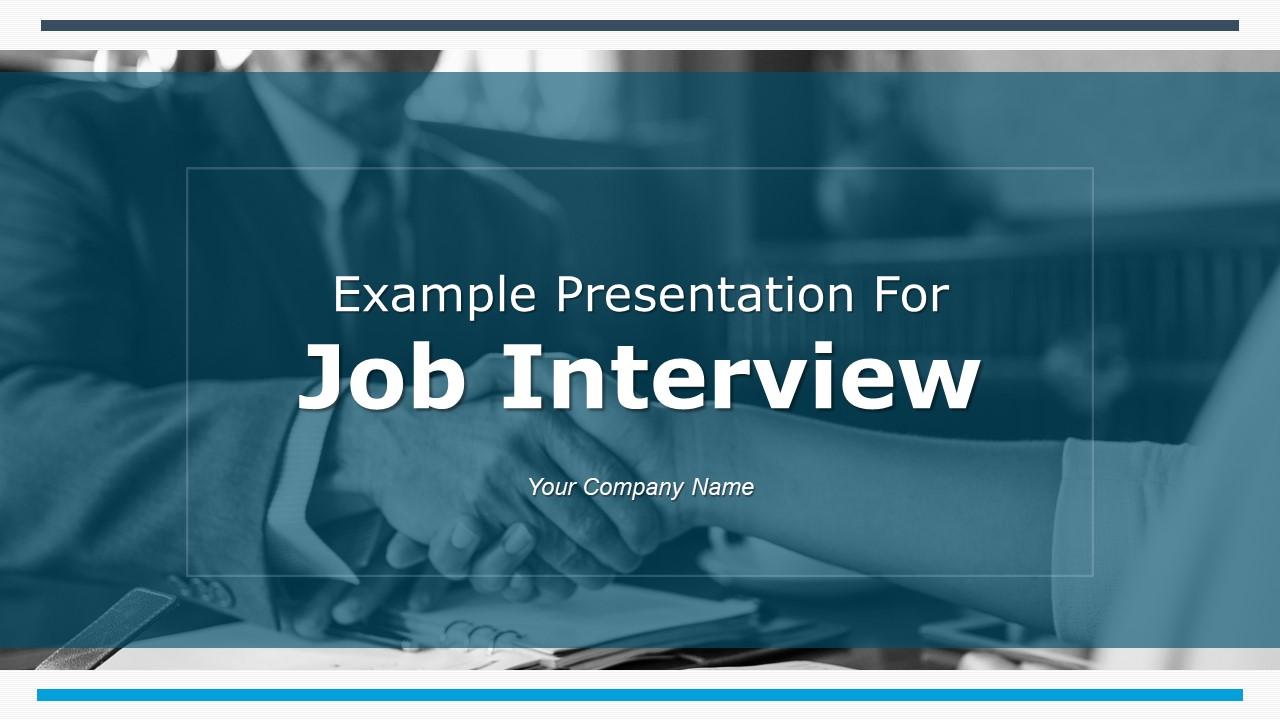
- Add a user to your subscription for free
You must be logged in to download this presentation.
Do you want to remove this product from your favourites?
PowerPoint presentation slides
This complete deck is oriented to make sure you do not lag in your presentations. Our creatively crafted slides come with apt research and planning. This exclusive deck with thirtyfour slides is here to help you to strategize, plan, analyse, or segment the topic with clear understanding and apprehension. Utilize ready to use presentation slides on Example Presentation For Job Interview Power Point Presentation Slides with all sorts of editable templates, charts and graphs, overviews, analysis templates. It is usable for marking important decisions and covering critical issues. Display and present all possible kinds of underlying nuances, progress factors for an all inclusive presentation for the teams. This presentation deck can be used by all professionals, managers, individuals, internal external teams involved in any company organization.

People who downloaded this PowerPoint presentation also viewed the following :
- Business Slides , Flat Designs , Strategic Planning Analysis , Complete Decks , All Decks , Interview Process , Career Planning , General , Introduction , Self Introduction
- Example Presentation For Job Interview ,
- Job Marketing ,
- Job Promotion
Content of this Powerpoint Presentation
Slide 1 : This slide introduces Example Presentation For Job Interview. State Your Company Name and begin. Slide 2 : This is an Agenda slide. State your agendas here. Slide 3 : This slide shows About Me with imagery and text boxes to explain about yourself. Slide 4 : This is another slide titled as About Me including- Personal Profile, Skills & Language, Achievements, Contact Info, Personal Profile, Hobbies, Education. Slide 5 : This slide presents Career with the help of a timeline. Explain about your career here. Slide 6 : This is an optional slide for Career. Slide 7 : This is another optional slide for Career with imagery and timeline. Slide 8 : This slide represents SWOT Analysis describing- Strengths, Threats, Opportunities, Weaknesses. Slide 9 : This is an optional slide for SWOT Analysis. Slide 10 : This slide showcases Professional Qualifications with imagery and text boxes. Slide 11 : This slide shows Achievements with imagery and text boxes to show information. Slide 12 : This slide presents Training with icons and additional text boxes. Slide 13 : This slide displays Experience - Project with imagery and text boxes. Slide 14 : This slide represents Case Study with Challenge, Solution and result. Slide 15 : This slide showcases Skills describing- Goal Oriented, Flexible, Team Player, Creative, Assertive. Slide 16 : This slide shows Language Skill with additional text boxes for detailed information. Slide 17 : This slide presents Hobbies as- Arts and culture activities, Seeing the people who are most important to me, Getting around in the world independently, Pursuing interests and hobbies, Physical activities and sports. Slide 18 : This slide displays Example Presentation For Job Interview Icons. Slide 19 : This is another slide continuing Example Presentation For Job Interview Icons. Slide 20 : This slide reminds us about 30 minute coffee break. Slide 21 : This slide is titled as ADDITIONAL SLIDES for moving forward. Slide 22 : This is Our Mission slide with text boxes to show information. Slide 23 : This is Our Main Team slide with names and designation. Slide 24 : This is About Us slide to show company specifications etc. Slide 25 : This is a Financial slide. Show finance related stuff here. Slide 26 : This is a Comparison slide to state comparison between commodities, entities etc. Slide 27 : This is Our Main Goal slide. Show your important goals here. Slide 28 : This is Quotes slide to highlight or state anything specific. Slide 29 : This is Location slide. Show location related data here. Slide 30 : This is a Timeline slide. Show information related with time period here. Slide 31 : This is Bulb or Idea slide to state a new idea or highlight specifications, information etc. Slide 32 : This is Our Target slide. Show your targets here. Slide 33 : This slide shows a Stacked Bar graph with two product comparison. Slide 34 : This is a Thank you slide with address, contact numbers and email address.
Example Presentation For Job Interview PowerPoint Presentation Slides with all 34 slides:
Use our Example Presentation For Job Interview PowerPoint Presentation Slides to effectively help you save your valuable time. They are readymade to fit into any presentation structure.

Use the About Me and Career slides to introduce yourself with relevant information such as personal profile, skills, achievements, education, and career timeline.
Use the SWOT Analysis slide to present your strengths, weaknesses, opportunities, and threats. You can also use the Skills slide to highlight your strengths such as goal orientation, flexibility, and creativity.
Yes, you can include additional slides such as Our Mission, Our Team, About Us, Financials, Comparison, Our Main Goal, Location, Timeline, Bulb or Idea, and Our Target slides.
Use the Language Skill slide to showcase your proficiency in different languages with additional text boxes for detailed information.
End your presentation with a Thank You slide that includes your contact information such as address, phone number, and email address.
Ratings and Reviews
Items 1 to 10 of 13 total
- You're currently reading page 1

February 28, 2024
by Sitti Lainun Humairah Azzahrah Sitti
January 22, 2024
January 19, 2023
November 10, 2022
by Zhiguo He
March 10, 2022
by O'Ryan Edwards
December 28, 2021
by Duane Ray
by mohamed magdy
December 8, 2021
by Mahsa Mehrangiz
November 16, 2021
by Ivan Wang
November 13, 2021

Got any suggestions?
We want to hear from you! Send us a message and help improve Slidesgo
Top searches
Trending searches

26 templates

6 templates

first day of school
69 templates

environmental science
37 templates

49 templates
12 templates
Self Introduction for a Job Interview
It seems that you like this template, self introduction for a job interview presentation, free google slides theme, powerpoint template, and canva presentation template.
Are you preparing for an important job interview? You can either use this Google Slides & PowerPoint template to make a lasting impression by doing a self-introduction, or you can use it to prepare something akin to a résumé! There are elegant geometric shapes and gradients, so the "grabbing attention" box can be ticked. Have a look at this design and, if necessary, make the most of the cover letter included, or add more shapes, since we've included more of them in the final slides as extra resources!
Features of this template
- 100% editable and easy to modify
- 7 different slides to impress your audience
- Contains easy-to-edit graphics such as graphs, maps, tables, timelines and mockups
- Includes 500+ icons and Flaticon’s extension for customizing your slides
- Designed to be used in Google Slides, Canva, and Microsoft PowerPoint
- 16:9 widescreen format suitable for all types of screens
- Includes information about fonts, colors, and credits of the resources used
How can I use the template?
Am I free to use the templates?
How to attribute?
Attribution required If you are a free user, you must attribute Slidesgo by keeping the slide where the credits appear. How to attribute?
Related posts on our blog.

How to Add, Duplicate, Move, Delete or Hide Slides in Google Slides

How to Change Layouts in PowerPoint

How to Change the Slide Size in Google Slides
Related presentations.

Premium template
Unlock this template and gain unlimited access
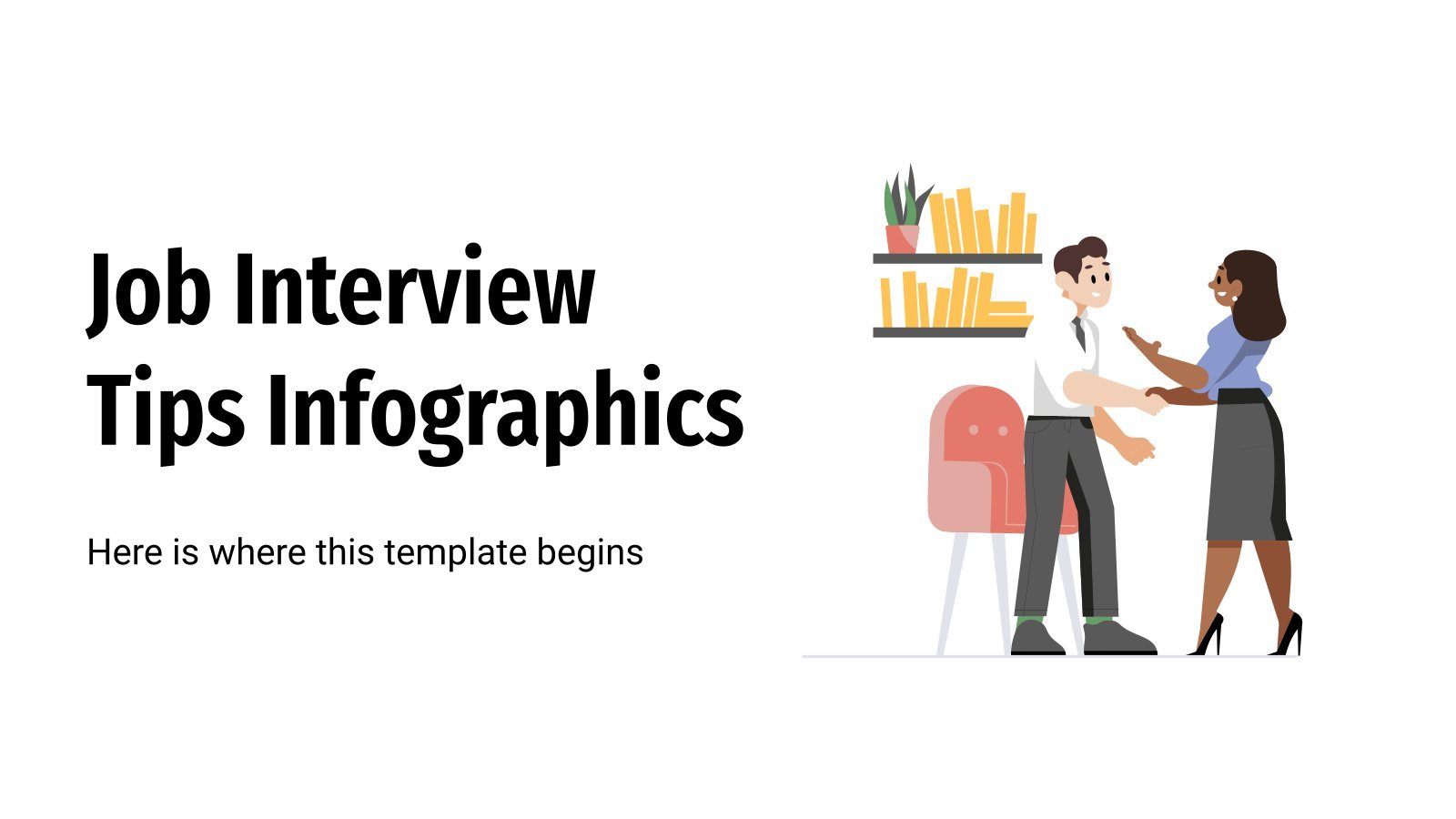
Register for free and start editing online

- PRESENTATION SKILLS
Presentations in Interviews
Search SkillsYouNeed:
Presentation Skills:
- A - Z List of Presentation Skills
- Top Tips for Effective Presentations
- General Presentation Skills
- What is a Presentation?
- Preparing for a Presentation
- Organising the Material
- Writing Your Presentation
- Deciding the Presentation Method
- Managing your Presentation Notes
- Working with Visual Aids
- Presenting Data
- Managing the Event
- Coping with Presentation Nerves
- Dealing with Questions
- How to Build Presentations Like a Consultant
- 7 Qualities of Good Speakers That Can Help You Be More Successful
- Self-Presentation in Presentations
- Specific Presentation Events
- Remote Meetings and Presentations
- Giving a Speech
- Presenting to Large Groups and Conferences
- Giving Lectures and Seminars
- Managing a Press Conference
- Attending Public Consultation Meetings
- Managing a Public Consultation Meeting
- Crisis Communications
- Elsewhere on Skills You Need:
- Communication Skills
- Facilitation Skills
- Teams, Groups and Meetings
- Effective Speaking
- Question Types
Subscribe to our FREE newsletter and start improving your life in just 5 minutes a day.
You'll get our 5 free 'One Minute Life Skills' and our weekly newsletter.
We'll never share your email address and you can unsubscribe at any time.
It is increasingly common to be asked to do a presentation as part of an interview. However, these presentations often have several important distinctions from others.
Fortunately, as long as you know what to expect, you can plan accordingly and make sure that your presentation is remembered for all the right reasons.
Forewarned is Forearmed
You have been invited to an interview for a job. The invitation to interview, however, has a paragraph at the bottom that says that, as part of the interview, you will be expected to present briefly (and a time limit is almost always given, usually five to ten minutes) on a given topic. You may be given a title, or asked to develop one.
There are a number of questions to which you may find it helpful to know the answers. For example:
- Will the presentation be in the same room as the interview?
- Will the interview happen first, or the presentation?
- Will you have access to a laptop and projector or similar?
- How many people will you present to?
You have a choice: do you phone up and ask, and risk looking a bit nervous, or do you just hope for the best?
The decision is really up to you. It is not unreasonable to ask if you will have access to a projector, and also if you can bring a handout for the interviewers. Other than that, you might have to play it by ear, and see if you feel able to ask more.
Who do you phone? It depends on who has invited you to the interview. If you have been invited by someone in the HR department, then it is not unreasonable to think of it as part of their job to deal with questions like that. If, on the other hand, you have been invited by someone quite senior, you might prefer to get in touch with their secretary or PA instead.
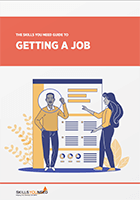
Further Reading from Skills You Need
The Skills You Need Guide to Getting a Job
Develop the skills you need to get that job.
This eBook is essential reading for potential job-seekers. Not only does it cover identifying your skills but also the mechanics of applying for a job, writing a CV or resume and attending interviews.
Developing the Content of your Presentation
It is reasonably common to ask you to present on something like the key challenges that you think you will face in your first month in the job , or how you plan to organise your induction into the new post .
Don’t panic! They don’t expect you to know what you’re doing before you’ve even started.
They do, however, expect you to have a reasonable idea of how to find out what you need to know.
Consider it your first test. Some good ways to approach information gathering include:
Phone a friend – do you know anyone working in that company or in a similar organisation or area of work? Give them a call, take them out for lunch, and pick their brains about the problems and challenges facing the company, and the area in which you will be working in particular.
Use the internet to do some research – as well as the company’s own website, have a look for news reports linked to the area in which you will be working and see what you can find out.
Use the clues in the job description and person specification – do these include requirements for particular skills that may not normally be associated with that kind of job? That might be a clue to a particular issue in the organisation.
Planning your Presentation
There are some general ideas about planning presentations on our pages Organising your Material and Writing your Presentation .
However, it’s important to think about a few points specific to interview presentations too, particularly:
You won’t be able to say everything that you’ve discovered in the space of five to ten minutes. Cut it down to the three main points that you want to make, and remember to emphasise that these are the three key areas.
What kind of visual aid will you use? If you are permitted to provide a one-page handout, how will it support your presentation?
How will you make your presentation stand out from among the crowd, in a good way? You may decide to do this by just being the best, or you could try starting by saying something memorable. Outrageous can work, but it can also be a bit risky, especially if you don’t know your interviewers. It depends a bit on the organisation and also the industry, so you will be best placed to decide what you can get away with.
Providing a Handout
Your one-page handout is what your interviewers will look at to remind them of your presentation. It therefore needs to showcase both the content of your presentation and your ability to summarise and show something in a brief visual form.
You could, of course, simply list your three key points, together with a few sentences about each one to summarise what you said. That will be perfectly acceptable.
But you could also produce something unique to you that showcases your thinking: a mind map, perhaps, or a visual summary of the situation, like a ‘rich picture’.
It does depend on how you think but, for more ideas, take a look at our page on Creative Thinking .
Ideally, you should use your handout as your notes for your presentation too, as it demonstrates that it really does capture your key points.
Handling Unusual Circumstances
You may well walk into your interview and find that something totally unforeseen has occurred.
For example, you have been told that you will be able to use PowerPoint, but there’s no laptop and projector because the interviewers have forgotten to organise it.
Don’t be thrown. Everyone else will be in the same situation.
Instead, use it as an opportunity to demonstrate that you are not put out by something unexpected since this is a valued skill. For example, have an alternative to slides, such as a one-page handout, or make a joke about technology always letting everyone down at crucial moments.
Your ability to handle problems in a good-humoured way will not go unnoticed.
Delivering your Presentation
You are unlikely to be expected to stand and deliver a presentation in an interview, because the room is likely to be very small.
However, it’s worth saying something like:
“ I think I’ll sit, as it’s a bit formal to stand. Unless of course you’d prefer me in full presentation mode? ”
They can then say if they want to see you do a formal presentation.
If you have been given a time limit for your presentation, do not go over it . You may have chosen not to practise fully, so as to be more spontaneous. However, be alert to how long your presentation is taking, and be ready to cut it short if necessary.
Do not rely on being able to see a clock in the room.
Instead, either take a clock that you can put on the table in front of you, or take off your watch, and place it where you can see it clearly at a glance.
It’s not a good idea to keep glancing at a watch on your wrist, as it is an off-putting piece of body language.
People are conditioned to read it as ‘ I don’t really have time for you ’, and this isn’t the impression that you want to give your interviewers, even inadvertently.
Remember to speak slowly and clearly, and check that your interviewers look like they have understood your points. Be alert for any body language that suggests lack of interest or disagreement, as you may want to develop those points further.
Make sure that you clearly conclude your presentation by summarising your key points, before inviting questions from the interview panel.
Presenting in a remote (online) interview
It is not unreasonable to be asked to make a presentation in an online interview.
However, it brings some additional challenges on top of presenting in person.
First, you need to be confident that you will be able to handle the technology , and share your slides with the interviewers. If you have not done this before, you have a choice. You can avoid having slides altogether, email through a one-page handout before the interview, or ask someone for help beforehand so that you know how to share your slides.
Second, you need to think about how you will appear . The section on presenting in our page on Remote Meetings and Conferences may be helpful here.
One Final Message…
Above all, remember that you will be at your best if you are relaxed and confident.
This is hard in any interview situation, but you are testing whether you want to work there as much as they are assessing you. Be yourself, as much in the presentation as in the interview itself. Focus on presenting you: your ideas, your plans. You will then have the best chance of getting the job if it is the right job for you.
Continue to: Interview Skills Coping with Presentation Nerves Dealing with Questions
See Also: Tricky Interview Questions and How to Answer Them Creating and Delivering the Perfect Job Interview Presentation The Most Important Skills for Job Assessments
50 PowerPoint interview questions to ask candidates
Hire seasoned powerpoint professionals without complications.
TestGorilla helps you identify talent with the right technical skills, personality type, and behavioral attributes for your organization.

Microsoft PowerPoint is a staple program for many businesses across the globe.
Professionals who know how to make the most of PowerPoint can assemble exceptional presentations and use it to disseminate intriguing ideas in a visual format.
But do you have the right person with the necessary PowerPoint skills on your team to help you create visually appealing presentations?
If you need to hire one, it’s critical that you test for PowerPoint skills and then interview applicants using the right PowerPoint interview questions.
Here are the 52 PowerPoint interview questions you can ask candidates to assess their skills.
Table of contents
10 general powerpoint interview questions to ask applicants, 5 general powerpoint interview questions and answers, 14 powerpoint interview questions related to features and components, 5 powerpoint interview questions and answers related to features and components, 26 powerpoint interview questions related to processes and keyboard shortcuts, 5 powerpoint interview questions and answers related to processes and shortcuts, 5 tips for using powerpoint interview questions , find and hire the right powerpoint expert with our selection of powerpoint interview questions.
Ask candidates these 10 PowerPoint interview questions to assess their general knowledge, skills, and experience related to PowerPoint.
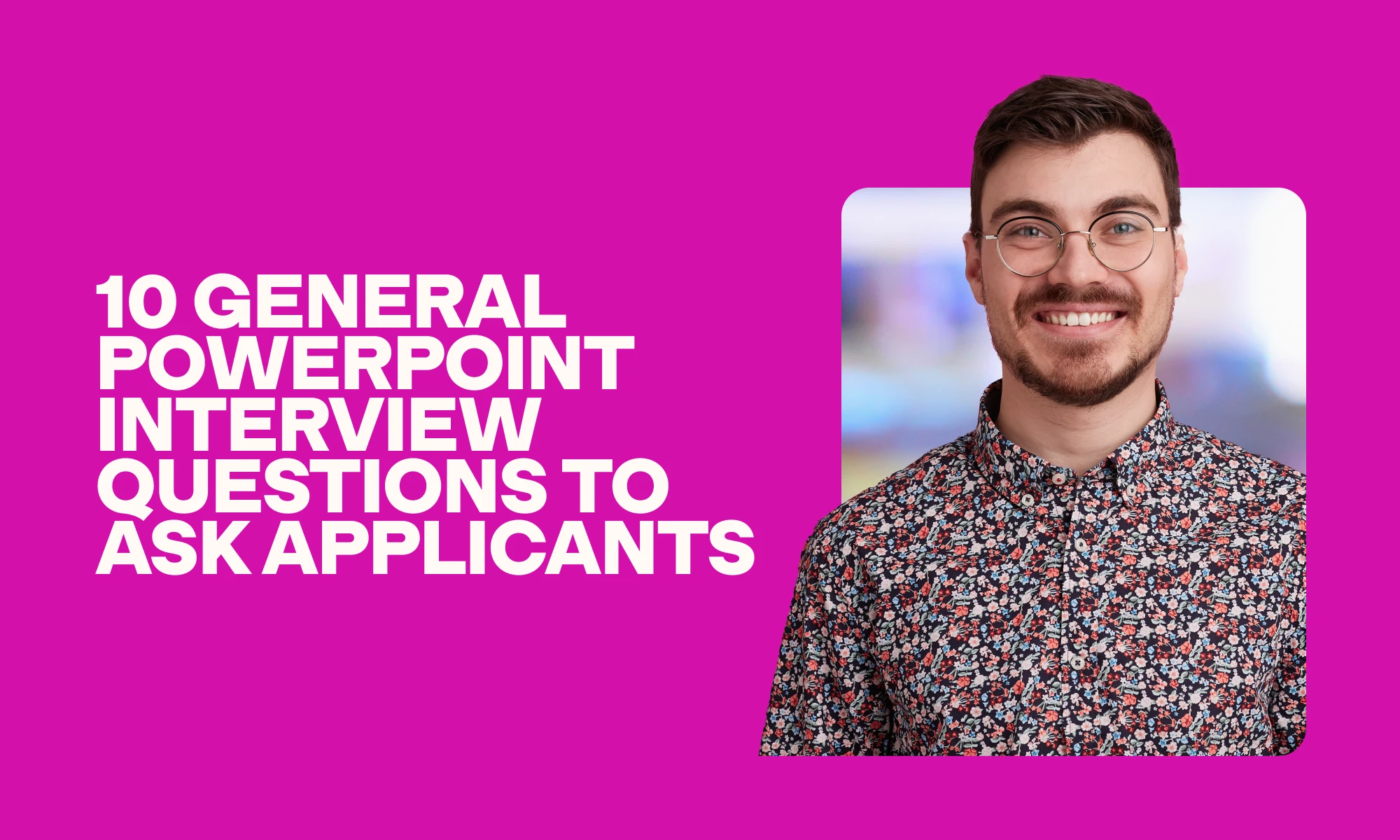
Explain what PowerPoint is.
Explain what you can use PowerPoint for.
What’s the default file extension of PowerPoint files?
What are the main components of the PowerPoint home screen?
Explain how to create new PowerPoint presentations.
What is the ribbon in PowerPoint?
What is a Trigger for animation?
Which skills are required to use PowerPoint?
Describe your experience with PowerPoint.
What are the advantages of using PowerPoint?
Here are five of the general PowerPoint interview questions above, along with answers you can use to evaluate your applicants’ responses.
1. Explain what you can use PowerPoint for.
Applicants who are seasoned PowerPoint users will know that this Microsoft Office tool helps show data or ideas in a presentation format using slides. Candidates should also understand that text, images, video, and audio can be added in a PowerPoint presentation.
2. What’s the default file extension of PowerPoint files?
Your applicants should know that PowerPoint files carry the . ppt or . pptx extension and that .ppt stands for “PowerPoint presentation.”
3. Which skills are required to use PowerPoint?
Do your candidates know that attention to detail is a vital skill required to use PowerPoint? They may also mention that Microsoft Office knowledge is critical for using PowerPoint efficiently.
4. What are the advantages of using PowerPoint?
There are three crucial advantages of using PowerPoint for presenting ideas and data:
Effortless organization: PowerPoint makes it easy to organize each item, arrange the order of slides, and set the layout of the master slide.
Professionally-looking designs: PowerPoint features many visually appealing designs and themes which users can customize easily.
Simple modifications: It’s easy to make changes to the available designs and add different items to the presentation.
5. What is the ribbon in PowerPoint?
Applicants should be aware that the ribbon is a menu that features labels and tabs at the top of the PowerPoint window. Users can navigate to different labels in the ribbon to access PowerPoint’s tools and features.
Ask your applicants these 14 PowerPoint interview questions related to the program’s features and components to thoroughly assess their PowerPoint knowledge.
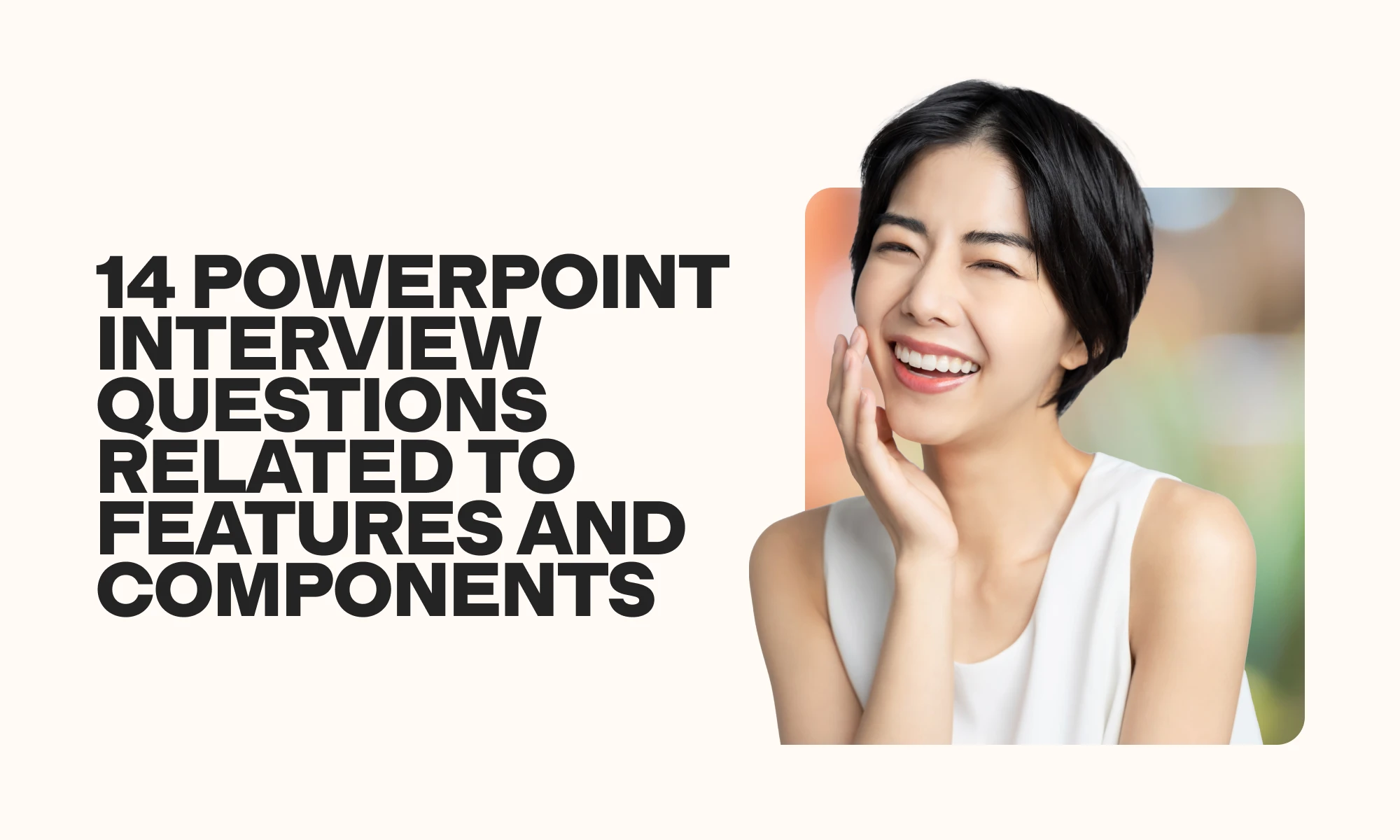
Explain what zoom control is.
Explain what live PowerPoint presentations are.
Explain what duration does in the PowerPoint animation pane.
Explain what a placeholder is.
Explain why transitions are useful in PowerPoint.
Explain what slide sorter view is.
Explain what a motion path is.
Explain what the notes pane does.
Explain what the eyedropper tool does in PowerPoint.
Explain what slide view does in PowerPoint.
What does the fit to window tab do in PowerPoint?
What does the insert tab do in PowerPoint?
What does the reading view do in PowerPoint?
Explain what the chart option does in PowerPoint.
Here are the answers to five of the PowerPoint interview questions related to features and components above. Use these to evaluate the depth of your applicants’ knowledge.
1. Explain what a placeholder is.
A placeholder is a pre-formatted section or area located on a PowerPoint presentation slide enclosed with dotted borders.
The dotted borders make it easier to identify where different placeholders are located. Placeholders are used to format slides consistently.
2. Explain why transitions are useful in PowerPoint.
Can your applicants explain that transitions in PowerPoint make it easier to present data in a visually compelling format?
Knowledgeable applicants may also explain that many different transitions, such as fade or dissolve, help capture the viewers’ attention for longer.
3. Explain what a motion path is.
Applicants should have no problem explaining that a motion path is an approach that presenters use to move or add motion to slide objects.
Can your applicants also explain that users can access the motion path option by selecting an object and navigating to the Animation tab?
4. Explain what slide view does in PowerPoint.
If your applicants have used PowerPoint extensively, they should know that slide view enables users to view the PowerPoint presentation slides in different modes, including:
Slide sorter
Reading view
5. Explain what zoom control is.
Applicants familiar with PowerPoint should know that zoom control enables users to zoom in and out of slides. Candidates should also know that they can access the zoom control option by navigating to the slide view tab.
Ask your applicants some of these 26 PowerPoint interview questions related to processes and keyboard shortcuts to determine whether their skills match your open role.
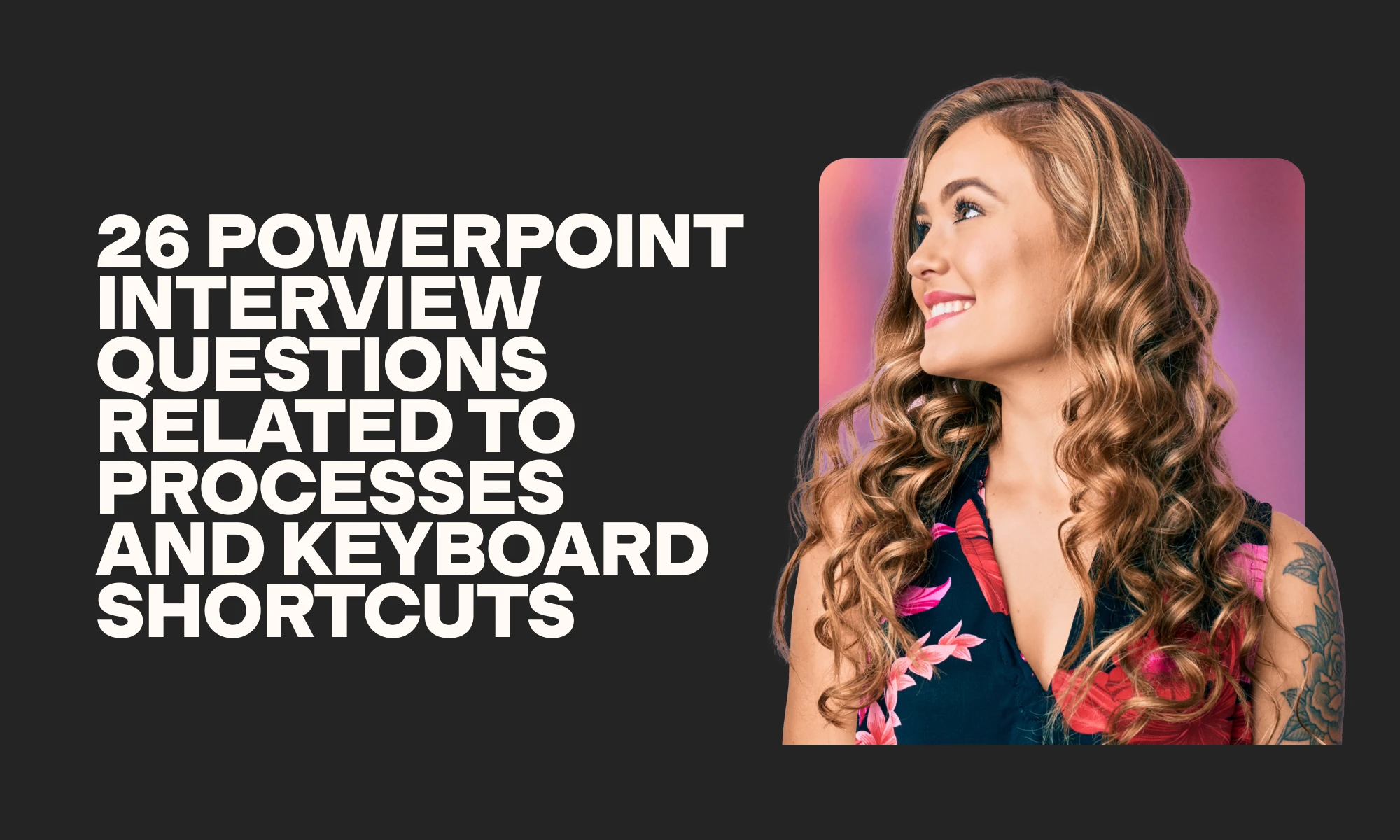
How would you set up a live PowerPoint presentation?
How would you add bookmarks to PowerPoint videos?
Which is the shortcut to add a new slide to a presentation?
Which steps would you use to set up password protection for a presentation?
Which shortcut keys would you use to start a PowerPoint presentation slideshow?
Which shortcut key would you use to exit a PowerPoint presentation slideshow?
How would you insert videos into a PowerPoint presentation?
Explain how you would add a motion path to a PowerPoint presentation.
Explain how you would change themes in PowerPoint.
How would you convert a PowerPoint presentation into a video?
How would you use PowerPoint to record a video?
How would you merge shapes and text?
How would you edit your presentation’s master slide?
How would you add a clickable list in PowerPoint?
Which shortcut keys would you use to open an existing document?
How would you embed an Excel chart into a PowerPoint presentation?
How can you customize the ribbon in PowerPoint?
How would you add a header to a PowerPoint presentation?
How do you add slide numbers to a PowerPoint presentation?
Which shortcut keys would you use to add a hyperlink to a presentation?
How would you create a PDF version of a PowerPoint presentation?
How would you use the eyedropper tool in PowerPoint?
How would you arrange your slides into different sections in PowerPoint?
How would you use the notes page view in PowerPoint?
How would you test an action button in PowerPoint?
How do you find new ideas for PowerPoint presentation designs?
Here are the answers to five of the above PowerPoint interview questions related to processes and keyboard shortcuts. Use them as a guide when evaluating your applicants’ PowerPoint skills.
1. Which steps would you use to set up password protection for a presentation?
Your applicants should be able to explain the steps required to set up password protection for a presentation. To protect a PowerPoint file with a password, you need to:
Navigate to File
Select the Passwords option
Select “ Encrypt this presentation and require a password to open .”
Enter the chosen password
Enter the password again to verify it
Press Set Password
2. How do you find new ideas for PowerPoint presentation designs?
Applicants should be aware that they can find ideas for PowerPoint presentation designs by navigating to the Design tab located on the ribbon. Users can then choose from the large selection of PowerPoint presentation designs that are available.
3. How would you edit your presentation’s master slide?
Your candidates should be able to explain the steps required to edit a presentation’s master slide in PowerPoint. For this, the user needs to
Navigate to View on the ribbon
Select Slide Master
Navigate to the first slide on the left pane (which is the master slide)
Make changes to the master slide by using the required ribbon options
Select the Close Master View option once they’re satisfied with the changes
4. Which shortcut keys would you use to add a hyperlink to a presentation?
Can your applicants explain that using the Ctrl + K shortcut key will open the Insert Hyperlink window? Do they know that users can then select a file or page to use as a hyperlink and then press OK to add it?
5. How would you add bookmarks to PowerPoint videos?
Applicants should be able to outline the required steps to add bookmarks to PowerPoint videos:
Open the presentation and selecting the video
Navigate to the part of the video to which the bookmark should be added
Select Playback and Add Bookmark
Candidates should also know a video can have several bookmarks and that users can view the bookmark on the video timeline.
If you’ve chosen to include some of our PowerPoint interview questions in your hiring process, here are some tips to ensure the whole process flows without any issues.
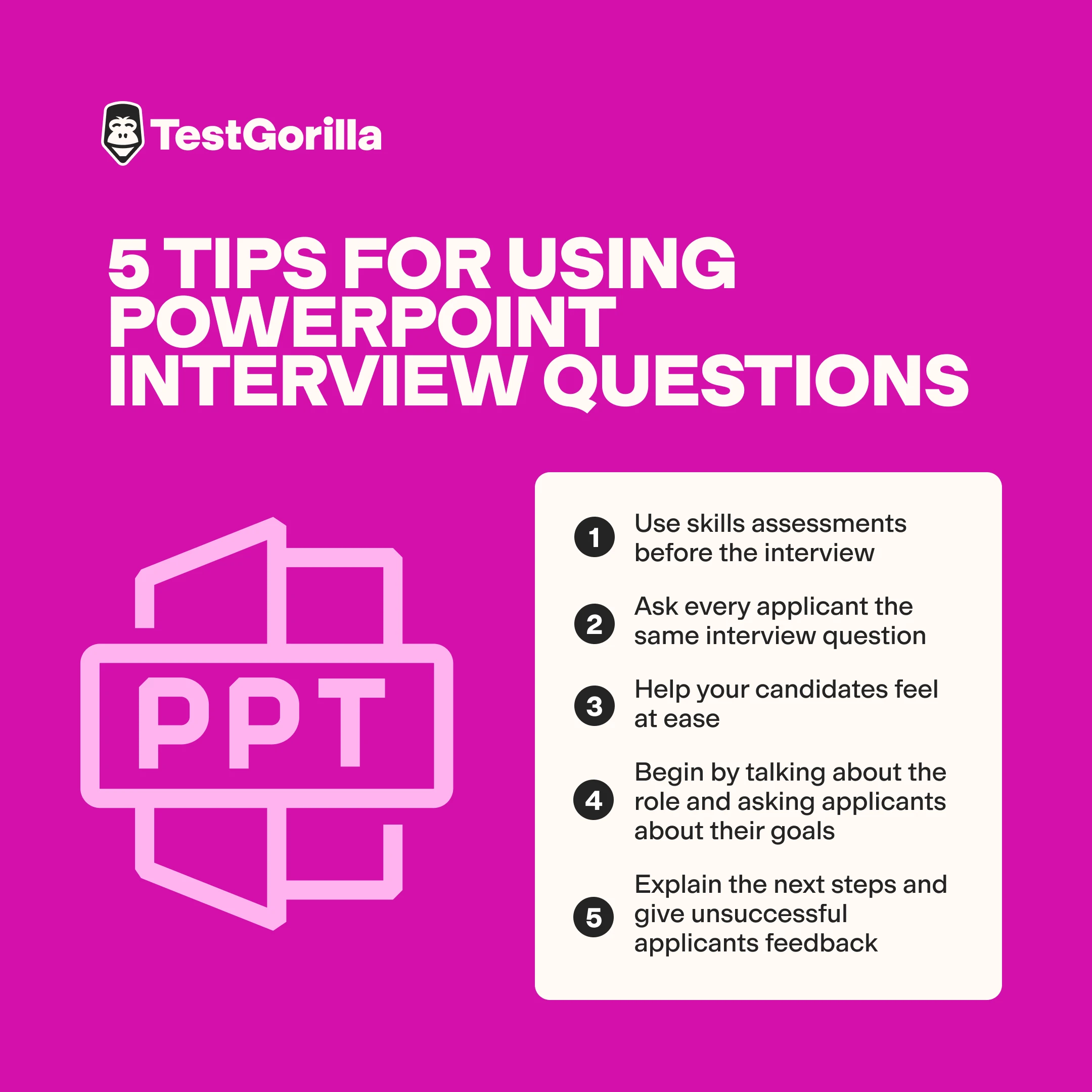
1. Use skills assessments before the interview
As soon as you receive applications for your open role, send invitations to your applicants to complete a skills assessment of up to five skills tests relevant to the position. Remember to add a PowerPoint test (preview below).
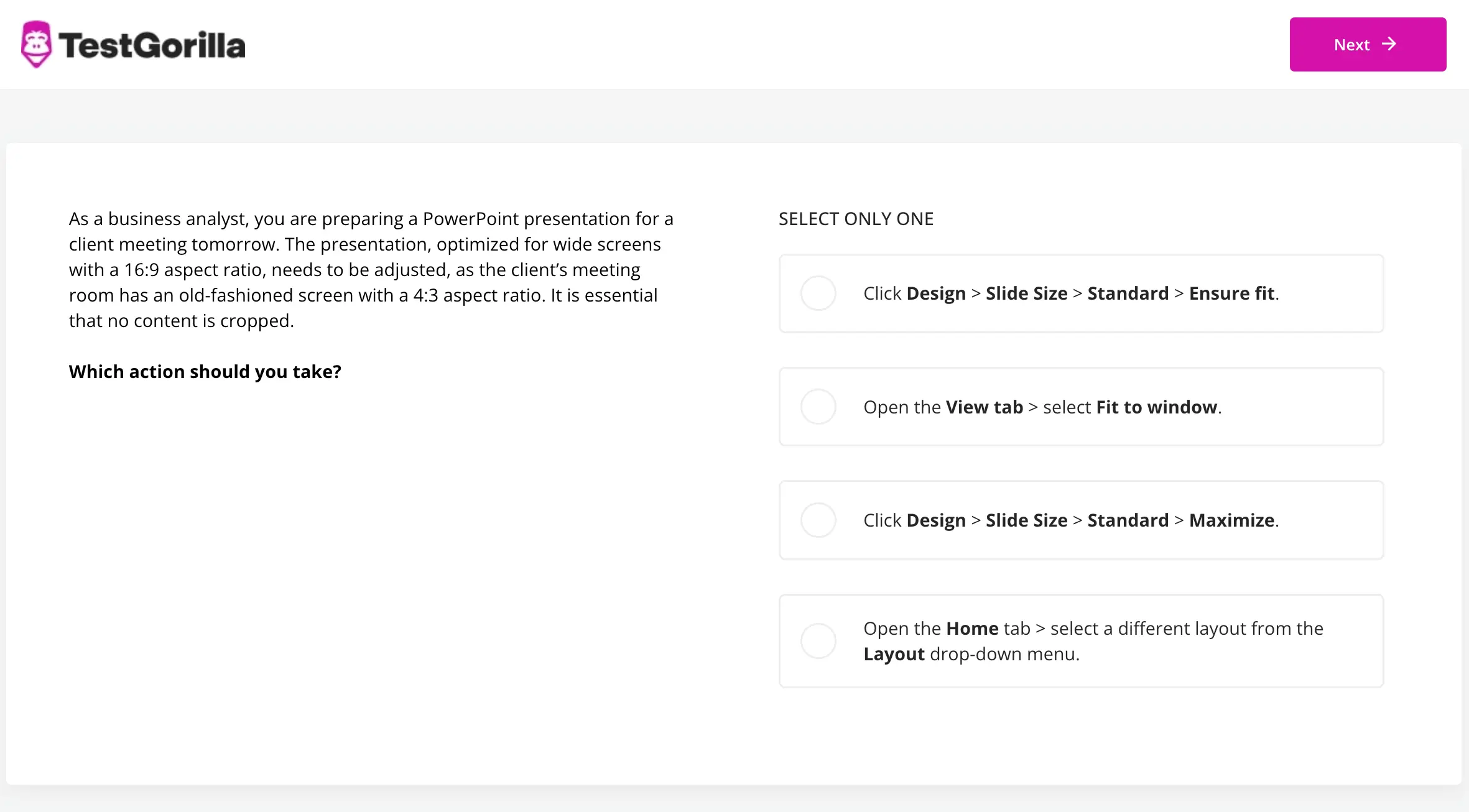
This method is the quickest, easiest, and most efficient way to effectively filter out applicants who don’t have the right skills you’re looking for – and aren’t proficient PowerPoint users.
Make a selection based on the test results and invite your best candidates to an interview. There, you can use the above PowerPoint interview questions, along with other relevant questions.
2. Ask every applicant the same interview questions
There’s no question that fairness and objectivity are essential during the hiring process – and technology can greatly help with that.
In addition to that, you should ask every applicant the same interview questions in the same or similar order. This is known as structured interviewing and is used by Google , among many other companies.
This approach also facilitates your work when you compare your applicants’ responses to make an objective hiring decision. For the best results, use it in combination with a scoring sheet.
3. Help your candidates feel at ease
Before you begin the interview and proceed to ask the core interview questions, make sure candidates feel at ease.
Welcome them to the building, offer them water, show them around the office, and ask them if they arrived okay at the building.
When you begin the interview, summarize the interview structure to let applicants know what to expect.
For example, let them know that the first part of the interview will involve discussing the organization and learning about the applicant’s goals. Inform applicants that you’ll then ask them a few interview questions and will close the interview by answering any questions they have for you.
4. Begin by talking about the role and asking applicants about their goals
Start the interview by briefly describing your organization and its main objectives. Follow this up by talking about the open role and giving applicants a description of its responsibilities, including details that weren’t mentioned in the job description.
Then, ask your applicants about their career goals to learn whether their ambitions align with the organization’s objectives.
5. Explain the next steps and give unsuccessful applicants feedback
After finishing the interview, explain the next steps to applicants. Inform them when you will next contact them and give them details about what to expect if they have been selected.
Once you have interviewed all candidates, give your unsuccessful applicants feedback using your notes from the interview and test results.
Stop guessing, start assessing with TestGorilla
TestGorilla can make your hiring process easier – all you need are our candidate assessments and the best interview questions in this guide.

Hiring the right PowerPoint expert for your organization doesn’t have to be difficult. Take a look at TestGorilla’s test library to see all the available skills tests and start selecting the right ones for your open role.
Once your applicants have completed your skills assessment (featuring a PowerPoint test), invite the most skilled ones to an interview and use the PowerPoint interview questions listed in this article to further evaluate their skills.
Hire a seasoned PowerPoint professional without complications, avoid costly mis-hires, and streamline your hiring process with TestGorilla. Get started for free today .
Related posts
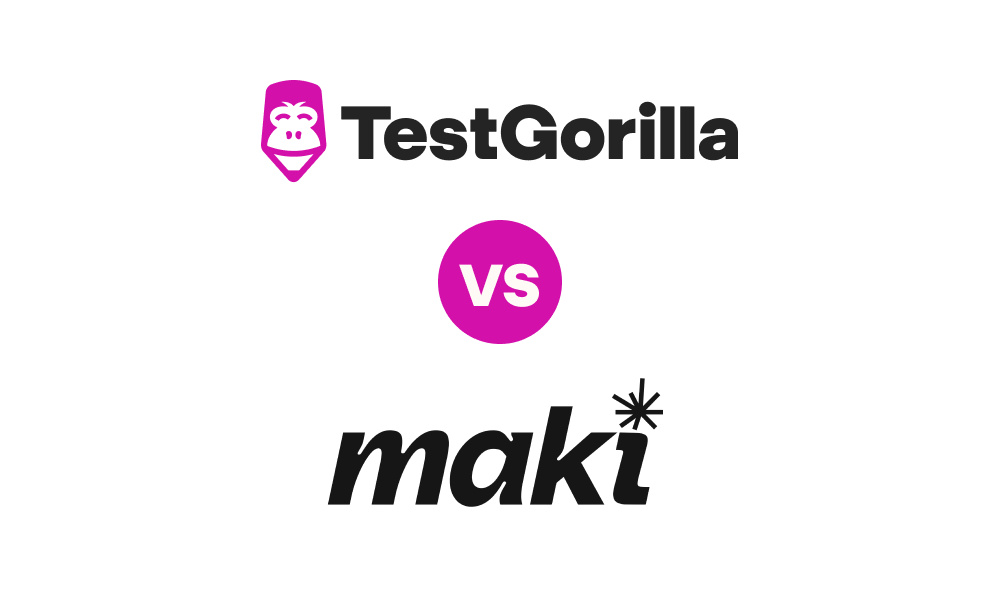
TestGorilla vs. Maki
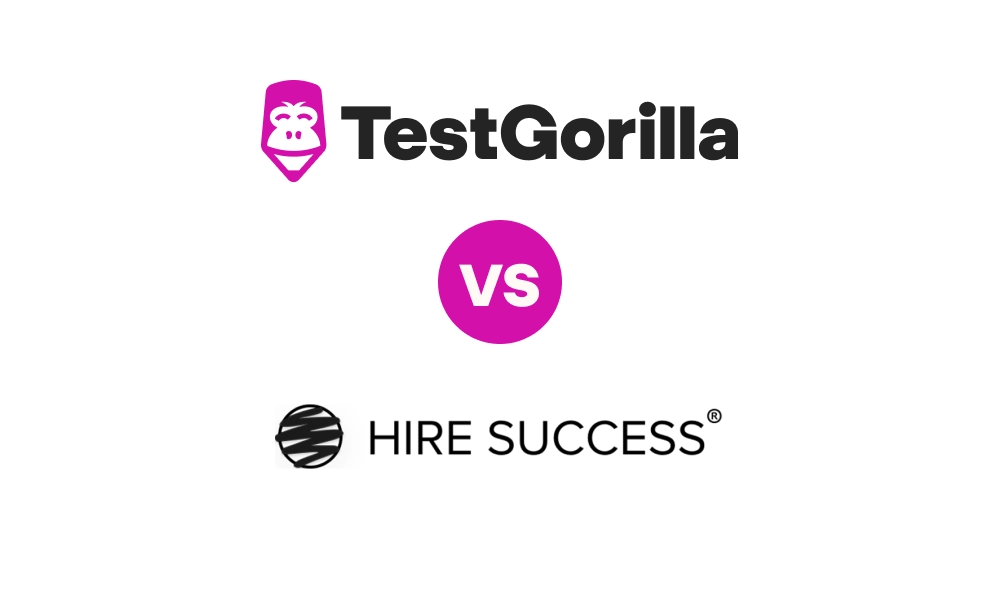
TestGorilla vs. Hire Success
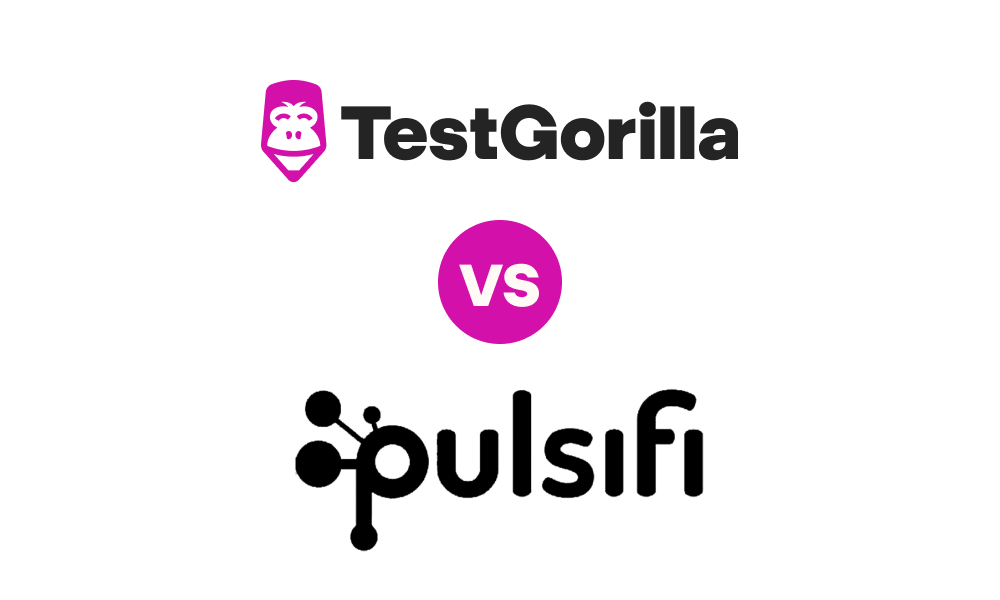
TestGorilla vs. Pulsifi
Hire the best candidates with TestGorilla
Create pre-employment assessments in minutes to screen candidates, save time, and hire the best talent.

Latest posts
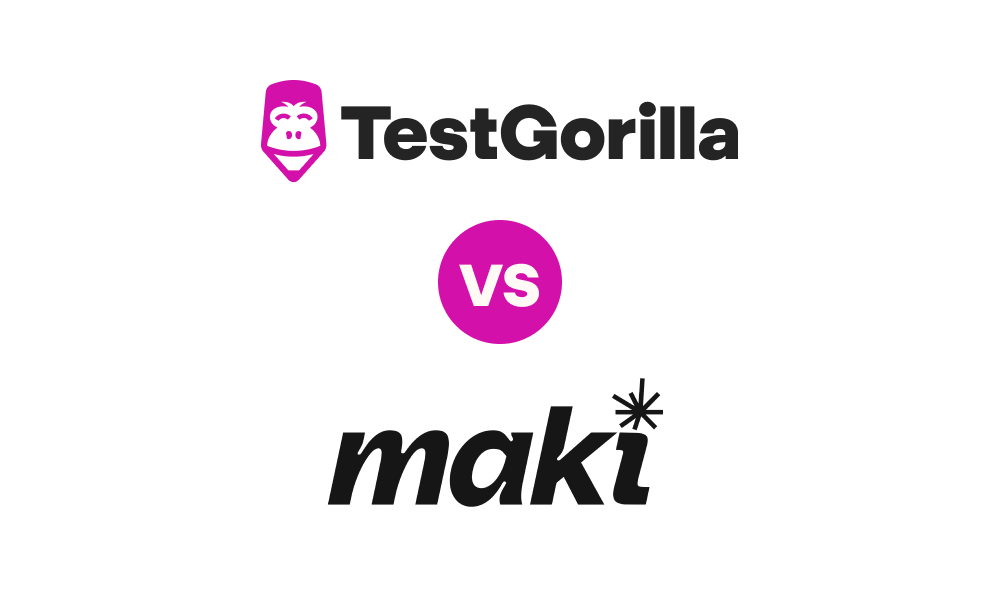
The best advice in pre-employment testing, in your inbox.
No spam. Unsubscribe at any time.
Hire the best. No bias. No stress.
Our screening tests identify the best candidates and make your hiring decisions faster, easier, and bias-free.
Free resources

This checklist covers key features you should look for when choosing a skills testing platform

This resource will help you develop an onboarding checklist for new hires.

How to assess your candidates' attention to detail.

Learn how to get human resources certified through HRCI or SHRM.

Learn how you can improve the level of talent at your company.

Learn how CapitalT reduced hiring bias with online skills assessments.

Learn how to make the resume process more efficient and more effective.

Improve your hiring strategy with these 7 critical recruitment metrics.

Learn how Sukhi decreased time spent reviewing resumes by 83%!

Hire more efficiently with these hacks that 99% of recruiters aren't using.

Make a business case for diversity and inclusion initiatives with this data.
- Open access
- Published: 24 May 2024
For the rural curious: mixed methods evaluation of a rural pharmacy practice elective
- Timothy P. Stratton 1
BMC Medical Education volume 24 , Article number: 573 ( 2024 ) Cite this article
134 Accesses
Metrics details
As of 2020, 20% of people residing in the United States of America (U.S.) lived in rural communities. Despite rural residents tending to be older, poorer, and having greater disease burden than their urban counterparts, the number of rural primary care providers continues to decline. Nearly 66% of U.S. Primary Care Health Professional Shortage Areas are designated as rural. Pharmacists can help address this shortage of rural primary care providers, often serving as providers of first-contact care; however, only 12% of U.S. pharmacists practice in rural communities. To help address this gap, in 2022 an elective Rural Pharmacy course was created at the University of Minnesota College of Pharmacy by a faculty member who has rural practice experience.
The course combines formal lectures, guest presentations by rural pharmacists and student interviews with additional rural pharmacists. For the 42 students enrolled in the course in 2022 and 2023, non-parametric statistics were used to compare the percentage of students who were raised in rural communities or who otherwise had extensive exposure to rural, and compare student interest ratings (1 to 7) about practicing/living rural at the beginning and end of the course. Students also wrote end-of-course reflection papers, commenting on the course and their interviews with rural pharmacists.
Across both years, 45% of the enrolled students had previous experience in rural communities. The net change in Rural Interest scores among students completing both questionnaires was + 5 in 2022 and + 2 in 2023, both non-significant differences. The largest shifts in student interest were from “Not Sure” at the start of the course to “Interested” or “Not Interested” at the end of the course, and from “Interested” to “Very Interested.” In their reflection papers nearly 60% of students reported being most impressed by their interviews with rural pharmacists.
Conclusions
A course addressing the benefits and challenges of practicing pharmacy in rural communities was well-received by pharmacy students. Even students who have little interest in living in a rural community can benefit from being introduced to rural culture, enabling them to provide more culturally-responsive care for patients from rural communities.
Peer Review reports
Introduction
The Unites States (U.S.) Census Bureau redefined “rural” for the 2020 census as communities with populations of fewer than 5,000 people (fewer than 2,000 housing units) and located more than 1.5 miles (2.4 km) from a high-density urban area. Based on this revised definition, 20% of the U.S. population in 2020 lived in rural communities [ 1 ]. The percentage of rural residents varied greatly by region, with only 11% of people in the West Region residing in rural areas, followed by 16% in the Northeast Region, 24% in the South Region and 26% in the Midwest Region [ 2 ]. At the extremes, fewer than 6% of people in California lived in rural areas, while nearly 65% of Vermont residents lived in rural areas [ 1 ]. In contrast, as of 2021 the U.S. Bureau of Labor Statistics reported that only 12% of the nation’s pharmacists practiced in nonmetro (rural) communities [ 3 ].
On average, rural residents tend to be older [ 4 ], poorer [ 5 ], experience greater disease burden [ 6 ] and lack health insurance or be underinsured [ 7 ] than residents of urban communities. The average age and disease burden among rural residents is increasing due to outmigration of young adults from rural to urban communities and the in-migration of older adults to rural communities following retirement [ 4 ]. Yet as the proportion of older residents in rural communities continues to increase, the availability of primary care providers in rural communities continues to decrease. Nearly 66% of Primary Care Health Professional Shortage Areas in 2023 are designated as rural [ 8 ]. Pharmacists can be part of the solution to address the existing and anticipated shortage of primary care providers in rural communities [ 9 ]. Rural pharmacists often serve as “providers of first-contact care” for patients who are seeking to self-treat a health condition [ 10 ]. Where self-treatment is inappropriate, the pharmacist is in a position to refer the patient to appropriate professional care.
This paper describes a new course taught in the Doctor of Pharmacy (PharmD) program in the University of Minnesota College of Pharmacy that introduces students to the unique benefits and challenges of practicing pharmacy in rural communities.
One college, two campuses
The University of Minnesota (UMN) is a public, research-intensive (Carnegie R1) institution. The UMN College of Pharmacy opened on the Minneapolis campus in 1892 [ 11 ]. Prior to 2003, the College of Pharmacy included four departments: Experimental & Clinical Pharmacology, Medicinal Chemistry, Pharmaceutics, and Pharmacy Care & Health Systems. However, to address a shortage of pharmacists in Greater Minnesota – counties outside of the seven-county Minneapolis-St. Paul Twin Cities Metro Area [ 12 ] – in 2003 the College of Pharmacy expanded its program 150 miles (241 km) north to Duluth on the University of Minnesota Duluth campus, adding a fifth department to the College, Pharmacy Practice and Pharmaceutical Sciences (PPPS).
The specific multi-campus model used by the UMN College of Pharmacy is somewhat unique among multi-campus pharmacy programs in the U.S. The PPPS department includes faculty representing Biochemistry and each of the major Pharmacy disciplines (Clinical Pharmacy, Medicinal Chemistry, Pharmaceutics, Pharmacology, Pharmacy Practice, and Social & Administrative Pharmacy). Didactic courses within the College are taught using videoconferencing technology, with classroom presentations/lectures originating from either Minneapolis or Duluth and being broadcast to the other campus.
The mission of the PPPS department includes preparing pharmacists to provide patient care in rural and Indigenous communities [ 13 ]. PPPS faculty embody this mission in all four areas of an academic health professions program, highlighting the unique health needs of rural residents in their teaching, addressing these needs through community-based participatory research [ 14 ], conducting service activities in rural communities, and providing clinical services. Until 2022, however, no single course in the College of Pharmacy’s curriculum was devoted specifically to rural health.
Rural pharmacy elective-course description and structure
To help address this gap in the College of Pharmacy curriculum, the author – a pharmacist who has practiced hospital, community and long-term care pharmacy in frontier/Indigenous communities in Alaska [ 10 ], Eastern Montana and Minnesota – created a two-credit elective course (two hours per week for 15 weeks) in Rural Pharmacy to introduce students to the benefits and challenges of living and practicing in rural communities. Development of the course was guided by the author’s teaching philosophy; to paraphrase Confucian philosopher Xun Kuang [ 15 ]: “Tell me and I will forget. Show me and I will remember. Involve me and I will understand.”
The Rural Pharmacy course was designed as a HyFlex course [ 16 ] that allows the learner to choose by which content delivery method they would like to learn. Learners in a Hyflex course may elect to attend a live class session in person in a classroom, may attend a live class session remotely via videoconference, or may learn online anytime. Each live class session is recorded to accommodate students who prefer to learn online during a given week, or throughout the entire course.
The Rural Pharmacy elective is a “modified” HyFlex design in that no in-person option is available. University of Minnesota College of Pharmacy faculty and students are accustomed to videoconferencing as a course delivery method, the college having used videoconference technology since 2003 to conduct live, in-person sessions for learners on campuses located 2.5 h apart from one other. Required and elective didactic courses delivered by videoconference are always recorded, enabling learners to view the recording at a more convenient time if they are unable to attend the live class session. Another reason that an in-person option for the Rural Pharmacy elective is not offered is that live course sessions are conducted in the evening to accommodate students from different years in the pharmacy program (P2 and P3) whose other courses are all on different schedules, and Minnesota’s frequent snowy and icy winter conditions are not always conducive to safe travel to and from campus, especially at night.
At the time of this writing, during the first three pre-clinical years University of Minnesota College of Pharmacy students are required to complete 15 credits of elective courses above and beyond their required courses. The Rural Pharmacy elective is open to students in the final two pre-clinical years of the PharmD program (P2 and P3), but enrollment is capped by the instructor at 25 students per offering. Live class sessions are conducted once weekly for two hours in the early evening by videoconference for all students, whether based in Duluth or in the Minneapolis-St. Paul Twin Cities area. The early evening hours avoid conflicts with students’ other courses, which are on different schedules between 8:00 am and 5:30 pm for both of the two years. Students are encouraged to attend as many live videoconference sessions as possible, especially when a guest presenter is scheduled; however, as noted above all class sessions are recorded for viewing or reviewing at a more convenient time. The recordings accommodate students who may be working in a pharmacy as a Pharmacy Intern or Pharmacy Technician at the time class is scheduled, or students who desire to review one or more recorded class sessions prior to the written midterm examination.
A University of Minnesota Post-Graduate Year 1 (PGY1) Rural Pharmacy Resident [ 17 ] serves as the Teaching Assistant for the course each year, participating in the live class sessions via videoconference. The Pharmacy Resident is based out of a rural community in central Minnesota, traveling to two other rural communities and providing comprehensive medication management services [ 18 ] to residents of all three communities. While maintaining patient confidentiality, the Resident shares with students their experiences caring for patients in rural communities, some stories being only a few hours old. In addition to regularly participating in live class sessions, the TA prepares and leads a class session on their own, and conducts the live session interviews with guest rural pharmacists as described below.
About half of the class sessions feature guest pharmacists who currently practice in rural communities, guests joining the live class sessions via videoconference. When a guest pharmacist is invited to participate in the course, the instructor provides the pharmacist with a list of potential interview questions that they would be asked to address during the class session. On rare occasions the visits with pharmacist(s) are pre-recorded either to better accommodate the pharmacist’s work schedule or because of time zone differences between Minnesota and the states where the pharmacists live/work. Pre-recorded interviews are played during the live class session, and students submit questions they would have asked the pharmacist had the pharmacist been able to join the class session in real time. Those questions are then summarized by the instructor and forwarded to the guest pharmacist to respond to as the pharmacist’s time allows. Pharmacists living and practicing in rural and Indigenous communities from throughout Minnesota and from as far away as Alaska have participated in the live sessions, either pre-recorded or in real time. In addition to rural pharmacists, guest presenters have included Advance Practice Nurses [ 19 ] from rural communities, and a Biologist who works with an Indigenous community on the impacts of climate change on the health of the community.
A variety of assessments are utilized in the course including reflection papers, an online multiple-choice/true–false/short answer midterm exam, written participation in online discussions, in-class student presentations and written summaries of interviews with pharmacists practicing in rural communities. The course is graded on a A,B,C,D,F letter grade scale. A total of 300 points are available across nine activities in the course, ranging in value from 5–50 points. The grading scale used in the course is the professional scale used in all of the college’s courses, an A grade being attained by students who earn at least 93% of the available points while students earning fewer than 60% of available points do not receive a passing grade. The possible number of points available on individual assignments are assigned by the instructor based on the amount of time and effort students are expected to expend on the assignment as well as the quality of each assignment’s deliverable.
At the start of the course students complete a brief 7-point Likert-type questionnaire regarding their familiarity with rural communities and interest in possibly practicing in a rural community. The questionnaires are confidential rather than anonymous as students complete the same questionnaire again at the end of the course. The course director uses student names to match start-of-course and end-of-course questionnaires to measure changes in student attitudes. Students also write a brief paper describing their experiences with rural communities and the reason for their interest in learning (or learning more) about living and practicing in rural communities. The instructor uses this information to tailor presentations in the course for the entire class based on the students’ familiarity with rural communities. This information also familiarizes the instructor with students’ backgrounds, enabling the instructor to invite specific students to share their rural experiences as relevant opportunities arise during live class sessions. The initial questionnaire and interest paper collectively constitute 8.37% of the course grade.
The online midterm examination is based on material provided in the textbook [ 20 ] or during instructor or Resident presentations. Students are tested on their knowledge about what constitutes “rural” as defined by several different U.S. government agencies, rural culture, challenges in rural public health, and opportunities and challenges related to practicing pharmacy in rural communities. The midterm exam score constitutes 16.7% of the course grade.
As mentioned previously, the HyFlex nature of the course accommodates students who are unable to attend the live videoconference sessions. All students, however, participate in weekly written online discussions based on the live videoconference session from that week. Live sessions are recorded so that any student may view and listen to the session at their leisure. In the online discussion, students are asked to respond to an instructor-generated question based on that week’s live class session. Students are asked to post their response first, then comment on the response of at least one other classmate. The Canvas learning management system [ 21 ] facilitates this learning approach, providing the instructor the option to require a student to post their response before reading the responses of classmates. Students who post their responses by the weekly deadline receive full participation credit for the week, rather than being graded on the length of their response or on the number of responses they make to classmates’ postings. As a HyFlex course, students are not awarded extra points for attending the live videoconference session, nor are they penalized for not participating in the live videoconference session. Participation constitutes 16.7% of the course grade.
Indigenous people began living in what today is referred to as Minnesota some 13,000 years ago. Among the earliest identifiable tribes in Minnesota were the Dakota (Sioux) circa 1000 CE and the Anishinaabe (Chippewa, Ojibwe) who arrived in the mid-1700s [ 22 ]. Today, Minnesota is home to four Dakota and seven Anishibaabe reservations [ 23 ], most of these communities being located in rural or frontier Minnesota counties. In contrast to these early inhabitants whose ancestors have lived in Minnesota for hundreds of years, today foreign immigrants are arriving in Minnesota in increasing numbers [ 24 ]. Many of these new arrivals settle in communities outside of the Twin Cities Metro Area [ 25 ]. This spectrum of diversity underlies the importance for healthcare providers to learn to provide culturally-responsive care [ 26 ]; therefore, students in the course learn about Indigenous people or foreign-born immigrants they might encounter if practicing in rural Minnesota. Each student is assigned a particular culture (not their own), and through readings about and/or interviews with members from that culture prepares a brief presentation they share with the class during a live videoconference session. Again, because this is a HyFlex course a student who knows in advance that they will be unable to attend class when they are scheduled to present are able to pre-record their presentation. Pre-recorded student presentations are played during the live course session. This exercise constitutes 16.7% of the course grade.
As students in this course are training to become pharmacists, they interview pharmacists who currently practice in rural communities (or who have practiced in a rural community in the recent past). These interviews supplement the rural pharmacy practice stories provided by the instructor, the Resident, and the pharmacists who present during class videoconference sessions. Most, but not all, of the pharmacists who participate in the course are the instructor’s former students from the UMN College of Pharmacy, Duluth. In addition to pharmacists with practice experience in rural Minnesota, pharmacists in the instructor’s circle of contacts from rural Alaska, Wisconsin and Michigan have participated in the course, as have pharmacists from four different rural Indian Health Service [ 27 ] /Tribal Health Clinics. Potential pharmacist participants are contacted by the course instructor before the course begins to gauge their interest and willingness to participate in a live class session or be interviewed by the students, and are provided with the list of interview questions that will be asked. Characteristics and practice settings of the pharmacists who participated during the first two offerings of the course are presented in Table 1 .
The instructor assigns the students to interview teams of two to three students who conduct structured interviews with the rural pharmacists who practice in community, critical access hospital [ 28 ], health system hospital or Indian Health Service/Tribal Health settings. Each student is assigned to one team to interview a community pharmacist, and then to a different team to interview the health system pharmacist. Where possible, teams are structured to reflect gender diversity and include students from different years in the pharmacy program. Each student team contacts their assigned pharmacist and schedules a telephone or videoconference interview. Interviews are intended to last no more than 30 min, but oftentimes go longer as the conversations between the students and the pharmacist range far beyond the structured questions provided by the instructor.
Each student submits written summaries of their two interviews. Each interview team provides informal presentations about their interviews to the class during a live videoconference class session. Each interview assignment constitutes 16.7% of the course grade.
At the end of the course, students once again complete the 7-point Likert-type questionnaire regarding their interest in possibly practicing in a rural community. The numerical results from this questionnaire are compared to the numerical results of the interest questionnaire that the student completed at the start of the course. Each student also writes a brief reflection paper regarding what they learned in the course about practicing pharmacy in a rural community, and what aspect of the course they found most interesting/helpful in their learning. As with the similar assignments at the beginning of the course, the final questionnaire and final reflection paper constitutes 8.37% of the course grade.
Rural pharmacy elective-topics
Topics presented in the course are listed in Table 2 . Topics for didactic sessions early in the course are based on selected chapters from the textbook required for the course, Foundations of Rural Public Health in America (2022), by Joseph N. Inungu and Mark J. Minelli [ 20 ]. The course also features interdisciplinary and interprofessional components. As noted earlier, one guest presenter is a PhD Biologist employed by one of Minnesota’s American Indian tribes. That individual addresses Climate Justice, explaining the impact of climate change on rural Indigenous communities. Also as noted earlier, a group of rural Advanced Practice Nurses in different subspecialties present a panel session addressing the challenges faced by the communities they serve, and describe how they interact with rural pharmacists in their communities.
Assessing course outcomes
The percentages of students enrolled in the course on each campus who reported growing up in a rural community or having spent considerable time visiting relatives who lived in rural communities were compared using Fisher’s exact test [ 29 ]. For students completing rural interest questionnaires both at the beginning and the end of the course, rating scores from both years and both campuses were combined and paired. Given the ordinal nature of the data, beginning/end of course ratings were evaluated using the Wilcoxon signed-rank test [ 30 ]. A two-tailed alpha value of 0.05 was selected as the criterion to indicate significance in all numerical comparisons.
For the first offering of the course in Spring, 2022 a total of 25 students completed the course. Spring 2023 had 17 students in the course. The demographics of the students in these two cohorts are summarized in Table 3 .
Between the first two offerings of this course, 25 students on the Minneapolis campus enrolled in the course. Of these 25, 10 (40%) reported growing up in a rural community or having spent considerable time visiting relatives who lived in rural communities. Among the 17 Duluth students enrolled in the course between the two years, nine (53%) reported having grown up or otherwise spent considerable time in rural areas. This difference was not statistically significant.
At the beginning and end of the course, students rated their interest in living/practicing in rural community using a 7-point Likert-type scale ranging from “1-No interest” to “7-When can I start?!” The results from the 36 students who completed both the pre and post questionnaires are presented in Fig. 1 .
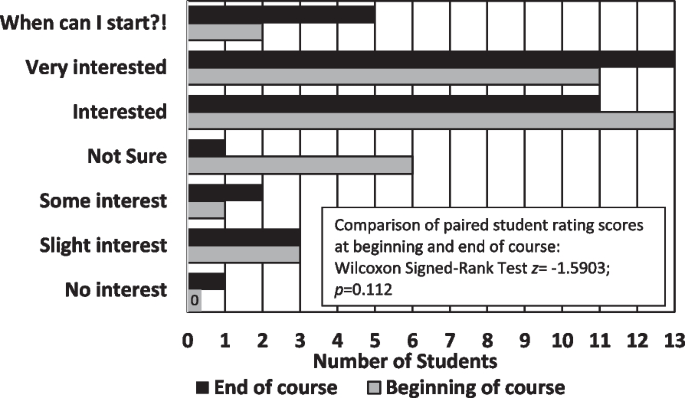
Interest in Practicing Pharmacy in Rural Communities ( n = 36)
The total net change in Rural Interest scores across all students completing both questionnaires was + 5 in 2022 and + 2 in 2023, some student scores increasing, others decreasing, and still others remaining the same. Results of the Wilcoxon Signed-Ranks Test were non-significant ( z = -1.5903; p = 0.112).
The largest change in scores occurred in the “Not sure” category (middle choice), with only one student remaining unsure of their interest in practicing in a rural community at the end of the course compared to six students at the beginning of the course. Four students who selected “Not sure” at the start of the course expressed lower interest in practicing in a rural community at the end of the course, one of these students moving down three levels from “Not sure” to “No interest.” One student who had selected “Interested” at the beginning of the course also dropped three levels at the end of the course to “Slight interest.” In contrast, several students who had selected “Interested” at the start of the course moved up to “Very Interested” or “When can I start?!”.
At the end of the course, students were asked to reflect on the impact of the course on their interest in practicing pharmacy in a rural community. Among the 42 students enrolled in the course during the first two years, 25 students in their reflection papers explicitly expressed appreciation for being able to interview pharmacists currently practicing in rural communities, while 20 explicitly expressed appreciation for having rural pharmacists and other professionals as guest speakers during class sessions. Two word clouds were generated from students’ reflection papers, one based on student perceptions of the benefits of living/practicing in a rural community (Fig. 2 ), and the other based on student perceptions of the challenges of living/practicing in a rural community (Fig. 3 ).
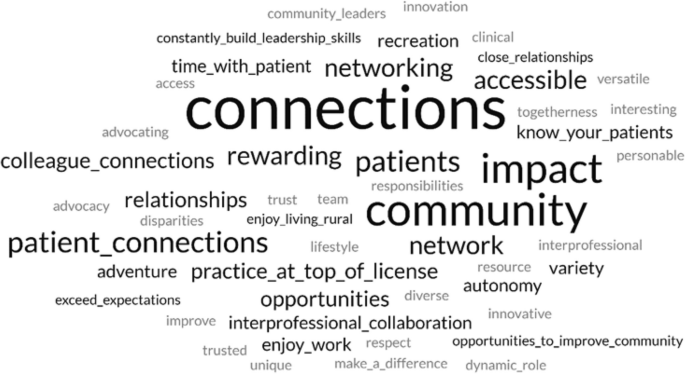
Word cloud featuring perceived benefits of living and practicing pharmacy mentioned in Rural Pharmacy students’ end-of-course reflection papers. “Courtesy of FreeWordCloudGenerator.com”
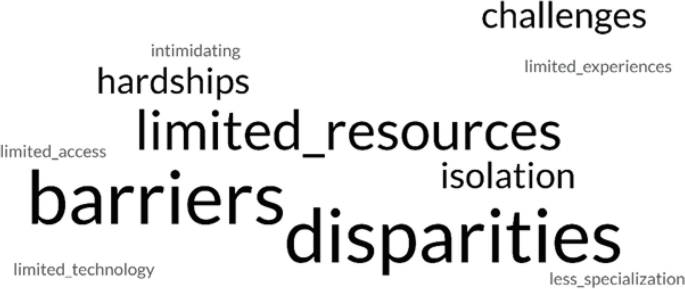
Word cloud featuring perceived challenges of living and practicing pharmacy mentioned in Rural Pharmacy students’ end-of-course reflection papers. “Courtesy of FreeWordCloudGenerator.com”
Representative student comments excerpted from their reflection papers regarding what they had heard from rural pharmacists who participated in the course are provided below. Each student’s comment is followed by that student’s final rating of their interest in practicing pharmacy in a rural community (1 = No interest, 7 = When can I start?!):
Before this course I had no interest in practicing rural before but now I’d at least entertain the idea after speaking and interviewing pharmacists that did or currently practice there. (Student selected ratings of 1 and 2) Hearing so many amazing stories, pharmacists are truly more than just “pill counting” because a single pharmacy can connect them with other rural health professionals, expanding the capabilities of rural pharmacists…. (2) If you can dream it you can do it in rural pharmacy. (5) It was great to have [the pharmacist I interviewed] in my network, as [they] said I can contact [them] anytime with questions outside… [of] my interview. I learned that having many contacts in your network, especially in rural areas, is so important…. (6) This class stimulated a future career interest that I already had, but was not sure exactly how to get started and who to ask if I had any questions. I feel like I now have many resources to reach out to when it comes to my future career, which makes me incredibly happy and comfortable. (7)
Students also expressed appreciation for other aspects of the course, whether the students were interested in practicing in a rural community at the end of the course or not. Again, each student’s comment is followed by that student’s final rating of their interest in practicing pharmacy in a rural community (1 = No interest, 7 = When can I start?!):
Even if I do not practice as a rural pharmacist, I will value the exposure and learning that has come from the topics covered in this course. (3) To be frank, I never even entertained the idea of practicing as a rural pharmacist. I’ve always wanted to work in an urban ambulatory care setting…. I did not expect the class to be as eye opening as it truly was…. I’m much more open to serving in a rural community and may consider it strongly . (3) It would be a huge adjustment to move to a rural area since I have grown up in [an urban community] my whole life. I want to work in a rural community since it is rewarding, but it is difficult to leave family behind and essentially start a new life with new people. (4) This is a rural pharmacy class, but it did not feel biased towards only working rural…. I came into this class knowing that I had an interest in rural pharmacy, but I did not expect to come out of this class even more interested in what rural areas have to offer. (6) Before starting this course, I knew that I wanted to practice pharmacy in a rural community…. Many times during this course we stated, “When you’ve seen one rural community, you’ve seen one rural community.” I did not know how true this statement was before this course…. Despite their vast differences, one common underlying theme is the health disparities seen in rural areas. (7)
It is important that health professions students be introduced to rural culture, even if they are “never” going to live/practice in a rural community themselves. With 5–64% of states’ populations living in rural communities [ 1 ], the odds are good that at some point in their careers, health professionals living in large urban centers are going to care for patients who have come from rural communities to receive more specialized care than is available locally [ 31 ]. Being introduced to rural culture can help students provide more culturally responsive care [ 32 ] to patients from rural communities during their careers.
The purpose of this course was to introduce pharmacy students to the advantages and challenges of practicing and living in rural communities. The course was not intended to “change hearts and minds” of students regarding their possible interest in practicing in a rural setting, and as can be seen from the results, students’ “interest in rural” ratings collectively neither significantly increased nor decreased between the beginning and the end of the course. Regardless, from comments in their reflection papers students generally appreciated the course, finding the interviews with rural pharmacists to be particularly valuable. This finding was heartening to the instructor who was initially concerned about the amount of out-of-class work being asked of the students.
Likewise, guest presenters who participated in the live class sessions and pharmacists interviewed by the students informally expressed their satisfaction with participating in the course, and expressed gratitude that this course was being offered. One pharmacist who previously practiced in a remote Alaska community but had recently moved to a major urban center in the “Lower 48” (Alaskan reference to states in the contiguous United States south of the 49th Parallel) expressed how much they enjoyed sharing their stories with the Rural Pharmacy students. The students with which this pharmacist currently works all desire to practice in large urban centers and are not particularly interested in hearing about the pharmacist’s experiences practicing in small, isolated communities. Another pharmacist noted that they really appreciated joining the students virtually in the live classroom, and was going to recommend this approach to other pharmacy schools with which they work as a way to generate interest in rural pharmacy in general, as well as interest in their particular pharmacy as a clinical rotation site.
A few changes were made in the roster of pharmacists participating in the course from year to year; however, most of the guest speakers and pharmacists who were interviewed by the students participated in the course both years. Another change being considered for the next offering of the course is to add a live videoconference session with a Minnesota Department of Agriculture “Farm Counselor” (a Licensed Professional Counselor) who makes in-person “farm calls” to address farm families’ mental health needs within the unique context of farm culture [ 33 ] (MN Dept of Ag, 2023).
A course specifically addressing the benefits and challenges of practicing pharmacy in rural communities was well-received by pharmacy students enrolled in the course, and by the rural guest presenters and rural pharmacists who were interviewed by the students. Even students who have little interest in living or practicing in a rural community can benefit from being introduced to rural culture, helping all students provide more culturally-responsive care for patients from rural communities.
Availability of data and materials
The data analyzed during the current study are not publicly available due to stipulations in the U.S. Family Educational Rights and Privacy Act (FERPA), but are available in de-identified form from the corresponding author on reasonable request.
Abbreviations
Students enrolled in years 1, 2 or 3 of the Doctor of Pharmacy (PharmD) program
Post-Graduate Year 1
Doctor of Pharmacy
Doctor of Philosophy
Pharmacy Practice and Pharmaceutical Sciences
Teaching Assistant
University of Minnesota
United States of America
United States Census Bureau. Nation’s urban and rural populations shift following 2020 Census. Press Release Number CB22-CN.25. Suitland (MD): U.S. Census Bureau; 2022. Available from: https://www.census.gov/newsroom/press-releases/2022/urban-rural-populations.html . Cited 2023 Aug 29.
United States National Center for Health Statistics. Health, United States, 2020-2021. Hyattsville (MD): U.S. Centers for Disease Control and Prevention; 2023. Available from: https://www.cdc.gov/nchs/hus/sources-definitions/geographic-region.htm . Cited 2024 Jan 22.
RHIhub. Rural Pharmacy and Prescription Drugs. [Internet]. Rural Health Information Hub. Available from: https://www.ruralhealthinfo.org/topics/pharmacy-and-prescription-drugs . Updated 2023 Jan 26; cited 2023 Aug 29.
Davis JC, Rupasingha A, Cromartie J, Sanders A. Rural America at a glance. Washington, DC: U.S: Department of Agriculture, Economic Research Service; 2022. Available from: Rural America at a Glance: 2022 Edition (usda.gov) . Cited 2023 Aug 29.
Google Scholar
United States Department of Agriculture Economic Research Service. Rural poverty & well-being. Washington, DC: U.S. Department of Agriculture; [updated 2022 Nov 29. Available from: USDA ERS - Rural Poverty & Well-Being . Cited 2023 Aug 29.
United States Centers for Disease Control and Prevention. About rural health. [Internet]. Atlanta (GA): Centers for Disease Control and Prevention. Available from: About Rural Health | CSELS | Rural Health | CDC . Updated 2023 May 09; cited 2023 Aug 29.
Turrini G, Branham DK, Chen L, Conmy AB, Chappel AR, De Lew N, Sommers BD. Access to Affordable Care in Rural America: Current Trends and Key Challenges. Washington, DC: United State Department of Health & Human Services, Assistant Secretary for Planning and Evaluation. Available from: https://aspe.hhs.gov/sites/default/files/2021-07/rural-health-rr.pdf . 2021 July 09; Cited 23 Aug 29.
United States. Department of Health & Human Services, Health Resources and Services Administration, Bureau of Health Workforce. Designated health professional shortage areas statistics. Washington, DC: U.S. Department of Health & Human Services. Available from: BCD_HPSA_SCR50_Qtr_Smry.pdf . Updated, 2023 Mar 31; cited 2023 Aug 29. https://data.hrsa.gov/Default/GenerateHPSAQuarterlyReport .
Council on Graduate Medical Education. Rural health policy brief 1. Special needs in rural America: Implications for healthcare workforce education, training and practice. Washington, DC: Health Resources & Services Administration. Available from: COGME Rural Health Policy Brief 1 (hrsa.gov) . Updated 2020 July 17; cited 2023 Aug 29.
Stratton TP. The economic realities of rural pharmacy practice. J Rural Health. 2001;17(2):77–81. https://doi.org/10.1111/j.1748-0361.2001.tb00261.x .
Article Google Scholar
Speedie MK, Ruhrold LN. A history of the University of Minnesota College of Pharmacy, 1892–2017. Research Triangle (NC): Lulu Press, Inc.; 2021. p. 285.
Nagel P, Yuan F. High-resolution land cover and impervious surface classifications in the twin cities metropolitan area with NAIP imagery. Photogrammet Eng Remote Sensing. 2016;82(1):63–71. Available from: https://www.researchgate.net/publication/288684001_High-resolution_Land_Cover_and_Impervious_Surface_Classifications_in_the_Twin_Cities_Metropolitan_Area_with_NAIP_Imagery .
University of Minnesota, College of Pharmacy, Department of Pharmacy Practice and Pharmaceutical Sciences. Minneapolis (MN): University of Minnesota College of Pharmacy; c2023. Available from: https://www.pharmacy.umn.edu/pharmacy-practice-pharmaceutical-sciences . Cited 2023 Aug 29.
United States Department of Health & Human Services, National Institute on Minority Health and Health Disparities. Community-Based Participatory Research Program (CBPR). NIH Guide No. RFA-MD-15-010. [Internet]. Bethesda (MD): National Institutes of Health. Available from: https://www.nimhd.nih.gov/programs/extramural/community-based-participatory.html . Updated 2018 Oct 02; cited 2023 Aug 29.
O’Toole, G. Quote Investigator. Xun Kuang. 2023. Available from: https://www.goodreads.com/quotes/7565817-tell-me-and-i-forget-teach-me-and-i-may . Cited 2023 Aug 29.
Beatty BJ. Hybrid-flexible course design: Implementing student-directed hybrid classes. 2019. Available from: https://edtechbooks.org/hyflex . Cited 2023 Aug 29.
University of Minnesota College of Pharmacy. Residency Sites & Emphasis Areas. Minneapolis (MN): University of Minnesota College of Pharmacy; c2023. Available from: https://www.pharmacy.umn.edu/degrees-programs/postgraduate-pharmacy-residency-program/residency-sites-emphasis-areas-2 . Cited 2023 Aug 29.
GTMRx Institute. c2019. Available from: https://gtmr.org/what-is-the-comprehensive-medication-management-process/ . Cited 2023 Aug 29.
American Nurses Association. Advanced practice registered nurse (APRN). [Internet]. Silver Spring (MD): American Nurses Association. Available from: https://www.nursingworld.org/practice-policy/workforce/what-is-nursing/aprn/ .
Ingunu JN, Minelli MJ. Foundations of rural public health in America. Burlington: Jones & Bartlett Learning; 2022. p. 491.
Canvas LMS. Salt Lake City (UT): Instructure. c2008-2023. Available from: https://www.instructure.com/canvas . Cited 2023 Aug 29.
Furst R. Which Indigenous tribes first called Minnesota home? Star Tribune [Internet] (Minneapolis, Minnesota). 2021. Available from: https://www.startribune.com/native-american-dakota-ojibwe-history/600097050/#:~:text=The%20earliest%20identifiable%20tribe%20in,Ojibwe%20in%20the%20mid%2D1700s . Cited 2023 Aug 29.
State of Minnesota. Minnesota Indian Tribes. St. Paul (MN): State of Minnesota. Available from: https://mn.gov/portal/government/tribal/mn-indian-tribes/#:~:text=In%20Minnesota%2C%20there%20are%20seven,links%20to%20other%20valuable%20resources.&text=What%20does%20the%20term%20Federally%20Recognized%20mean%3F . Cited 2023 Aug 29.
American Immigration Council. Immigrants in Minnesota. Washington, DC: American Immigration Council. c2023. Available from: https://map.americanimmigrationcouncil.org/locations/minnesota/?_gl=1*5ervbb*_ga*MTYyMDYyNjcyNy4xNjkyMjExNzI4*_ga_W0MSMD2GPV*MTY5MjIxMTcyOC4xLjEuMTY5MjIxMTk3Mi4wLjAuMA . Cited 2023 Aug 29.
Minnesota Chamber of Commerce. Economic contributions by region. St. Paul (MN): Minnesota Chamber of Commerce. 2021 Mar 23. Available from: https://www.mnchamber.com/blog/economic-contributions-region . Cited 2023 Aug 29.
Prasad SJ, Nari P, Gadhvi, K, Barai I, Danish H, Philip AB. Cultural humility: treating the patient, not the illness. Med Educ Online. 2016 Feb 3;216;21: 10.3402/meo.v21.30908. Available from: https://www.ncbi.nlm.nih.gov/pmc/articles/PMC4742464/ . Cited 2023 Aug 29.
U.S. Department of Health and Human Services, Indian Health Service. Rockville (MD): U.S. Department of Health & Human Services. Available from: https://www.ihs.gov/ .
Centers for Medicare and Medicaid Services. Critical Access Hospitals. Woodlawn (MD): Centers for Medicare and Medicaid Services; [updated 2021 Dec 12. Available from: https://www.cms.gov/medicare/provider-enrollment-and-certification/certificationandcomplianc/cahs . Cited 2023 Aug 29.
Siegel S. Fisher’s exact test. Nonparametric statistics for the behavioral sciences. New York: McGraw-Hill. 1956. pp 96–104.
Siegel S. Wilcoxon signed-rank test. Nonparametric statistics for the behavioral sciences. New York: McGraw-Hill; 1956. pp. 75–83.
Casey M, McCullough J, Kreiger R. Which Medicare patients are transferred from rural emergency departments? [Internet]. Minneapolis (MN): University of Minnesota Rural Health Research Center. 2014. p. 19. Available from: https://rhrc.umn.edu/wp-content/uploads/2017/11/whichmedicarepatientsaretransferred.pdf . Cited 2023 Aug 29.
Minnesota Department of Health. Culturally responsive care. St. Paul (MN): Minnesota Department of Health. 2019 May 01. Available from: https://www.health.state.mn.us/docs/communities/titlev/cultresponsive.pdf . Cited 2023 Aug 29.
Minnesota Department of Agriculture. Stress&Crisis: Get Help Now. St. Paul (MN): Minnesota Department of Agriculture. c2023. Available from: https://www.mda.state.mn.us/about/mnfarmerstress/copingstress . Cited 2023 Aug 29.
Download references
Acknowledgements
Not applicable.
No funding was received for this project.
Author information
Authors and affiliations.
University of Minnesota College of Pharmacy, Duluth, MN, USA
Timothy P. Stratton
You can also search for this author in PubMed Google Scholar
Contributions
T.P.S. solely conceived and undertook all aspects of this project and preparation of this manuscript.
Author’s information
TPS is Professor of Pharmacy Practice in the University of Minnesota College of Pharmacy, Duluth. He has practiced community, hospital and long-term care pharmacy in frontier communities in Southeast Alaska, and at Indian Health Service/Tribal Health clinics in frontier Alaska and eastern Montana, and in rural Minnesota. He is a member of the Rural Pharmacy Consortium , a Past Chair of the Small and Rural Hospital Section Advisory Group for the American Society of Health-System Pharmacists, and a Past President of the Minnesota Rural Health Association.
Corresponding author
Correspondence to Timothy P. Stratton .
Ethics declarations
Ethics approval and consent to participate.
Approval - The Institutional Review Board (IRB) of the University of Minnesota determined that this project constituted Exempt Research.
Informed consent - The Institutional Review Board (IRB) of the University of Minnesota waived the need for informed consent in this project.
Consent for publication
Competing interests.
The authors declare no competing interests.
Additional information
Publisher’s note.
Springer Nature remains neutral with regard to jurisdictional claims in published maps and institutional affiliations.
Rights and permissions
Open Access This article is licensed under a Creative Commons Attribution 4.0 International License, which permits use, sharing, adaptation, distribution and reproduction in any medium or format, as long as you give appropriate credit to the original author(s) and the source, provide a link to the Creative Commons licence, and indicate if changes were made. The images or other third party material in this article are included in the article's Creative Commons licence, unless indicated otherwise in a credit line to the material. If material is not included in the article's Creative Commons licence and your intended use is not permitted by statutory regulation or exceeds the permitted use, you will need to obtain permission directly from the copyright holder. To view a copy of this licence, visit http://creativecommons.org/licenses/by/4.0/ . The Creative Commons Public Domain Dedication waiver ( http://creativecommons.org/publicdomain/zero/1.0/ ) applies to the data made available in this article, unless otherwise stated in a credit line to the data.
Reprints and permissions
About this article
Cite this article.
Stratton, T.P. For the rural curious: mixed methods evaluation of a rural pharmacy practice elective. BMC Med Educ 24 , 573 (2024). https://doi.org/10.1186/s12909-024-05539-3
Download citation
Received : 18 September 2023
Accepted : 08 May 2024
Published : 24 May 2024
DOI : https://doi.org/10.1186/s12909-024-05539-3
Share this article
Anyone you share the following link with will be able to read this content:
Sorry, a shareable link is not currently available for this article.
Provided by the Springer Nature SharedIt content-sharing initiative
- Rural pharmacy
- Pharmacists
- Rural health
- Pharmacy education
BMC Medical Education
ISSN: 1472-6920
- Submission enquiries: [email protected]
- General enquiries: [email protected]

IMAGES
VIDEO
COMMENTS
Interview presentations have now become the new norm for most industries. They are popular for sales, marketing, technology, and academic positions. If you have been asked to deliver one for your job interview presentation, prepare to build a strong case for yourself as a candidate. Giving a general presentation is already daunting.
Here's a list of steps to consider if you want to make a presentation: 1. Do your research. The first step is to do some research and gather all of the information you require. The nature of this information depends on the subject of your presentation. For instance, if you're applying for a marketing position, the hiring organisation might want ...
The "10 Minute PowerPoint Presentation" might be a valuable tool for overcoming the anxiety associated with presenting oneself in business meetings and interviews. These creatively and precisely designed templates offer a comprehensive how-to for exhibiting your accomplishments, abilities, professional path, and more in just ten minutes.
What to include in an interview presentation template. Here are seven components you can think about when preparing your interview presentation template: 1. Type and topic of presentation. Before you begin preparing for a presentation, consider selecting a method of presentation. This can influence the type of template you create.
Keep eye contact throughout your job interview PowerPoint presentation, particularly when making a crucial point. 9. Conclude powerfully. Create a memorable conclusion to ensure your presentation is as compelling as possible. A broad, open-ended question that came up throughout your study could be an excellent way to wrap up. A one- to three ...
A job interview presentation is all about selling yourself. Be confident, speak clearly, and make eye contact with the interviewer. Don't be afraid to promote yourself and highlight your achievements. This is your chance to really show the interviewer that you are capable and have the necessary skills to do the job.
Step 5: Practice Your Delivery. Rehearse presenting your PowerPoint to ensure a smooth delivery on the day of the interview. Practice makes perfect. Rehearse your presentation several times to get comfortable with the flow and timing. Anticipate questions you might be asked and prepare answers.
Presentation of a specific project - for example if you apply for job in software development company, you can prepare a PowerPoint presentation of one of the projects you led. From first draft and planning of the application through setting milestones to completing them. Such a presentation helps you to demonstrate your excellent pm skills.
5. Scorecard. An essential part of any 90-day plan is building a report out. As you put your thoughts to paper, be sure to include the summary of actions, progress, and updates your manager will see each week. Design your report out in an easy to follow summary you can update each week. Think of it as a mini billboard of your accomplishments.
Keep the interviewer engaged, make them think and question. This is as much about how you fit with them as them fitting with you. Think of your presentation as one half of a conversation that you will lead, rather than a monologue where you will bludgeon them with facts and statistics. You need to take your listener (s) with you, get them ...
Interview presentations are common for roles that require communicating information to large groups of people, including sales representatives, business analysts, managers, product managers and client-facing positions. Thoroughly preparing for your presentation can help you feel more confident and capable during your interview, allowing you to ...
JOB INTERVIEW PRESENTATION (How To Give A Brilliant Presentation In An INTERVIEW!) EXAMPLE INCLUDED! https://passmyinterview.com/how-to-give-a-job-interview-...
You've got an option between free and premium templates. Free job interview presentation templates are generally background images or three-slide files. You'd still need to have good design skills to use free templates found online. If you need to be more efficient, go premium. Envato Elements has the best PowerPoint templates for job interviews.
Deliver your presentation to family or friends in advance of the interview to learn more about what you might be saying nonverbally. 9. Use clear diction and adequate volume. A benefit of standing is that it makes it easier to breathe deeply and speak with adequate volume, so you are easily understood.
6 C's to Consider to Give Top-Notch PowerPoint Presentation for Job Interview. Psychologically, you need to do a couple of preliminary things to recognize what interviewers are looking for in the first place. Let's review what they specifically search: 1. Communication. They will look at how you communicate, articulate, or are cohesive and ...
A PowerPoint presentation for a job interview is a great way for you to sell yourself as a future employee and for your potential employers to learn more about you. In this article, we'll outline the benefits of interview presentations as well as best practices and tips for creating and presenting them.
Ace your next job interview with these interview presentation templates. Whether you're a recent graduate or a seasoned professional, these templates will help you showcase your skills and experience in a visually appealing way. With a variety of customizable slides, you can easily manage your resume and highlight your achievements.
Open PowerPoint and navigate to the slide where you want to add an object. Click on the "Insert" tab in the top menu bar. To add a picture, click on the "Pictures" button and select the image you want to add. To add a shape, click on the "Shapes" button, select the desired shape and then click and drag on the slide to draw the shape.
Slide 1: This slide introduces Example Presentation For Job Interview.State Your Company Name and begin. Slide 2: This is an Agenda slide.State your agendas here. Slide 3: This slide shows About Me with imagery and text boxes to explain about yourself. Slide 4: This is another slide titled as About Me including- Personal Profile, Skills & Language, Achievements, Contact Info, Personal Profile ...
You can either use this Google Slides & PowerPoint template to make a lasting impression by doing a self-introduction, or you can use it to prepare something akin to a résumé! There are elegant geometric shapes and gradients, so the "grabbing attention" box can be ticked. Have a look at this design and, if necessary, make the most of the ...
Be yourself, as much in the presentation as in the interview itself. Focus on presenting you: your ideas, your plans. You will then have the best chance of getting the job if it is the right job for you. It's not uncommon to be asked to do a presentation as part of an interview. Learn more about what to expect and how to handle these ...
5 PowerPoint interview questions and answers related to features and components. Here are the answers to five of the PowerPoint interview questions related to features and components above. Use these to evaluate the depth of your applicants' knowledge. 1. Explain what a placeholder is.
The instructor assigns the students to interview teams of two to three students who conduct structured interviews with the rural pharmacists who practice in community, critical access hospital [], health system hospital or Indian Health Service/Tribal Health settings.Each student is assigned to one team to interview a community pharmacist, and then to a different team to interview the health ...